I’ll start with a confession: I’m not a huge fan of the Lord of the Rings books. I found the story meandering and slow, the characters one-note and boring, the action kind of flat. The movies changed my view quite a bit. The mythology and the world grew on the big screen, and for the first time I understood why so many people across so many generations fell in love with Tolkien’s creation. All it took was a change of perspective.
And now Wizards of the Coast is bringing another change of perspective with Lord of the Rings: Tales of Middle-Earth. Based on the trilogy of books, it’s full of characters and locations and events from the series, and contains themes designed to evoke the action of the story. This will be massively appealing to fans of Lord of the Rings. And for those who are not? LTR still has the awesome mix of traditional Magic gameplay and new mechanics that makes each set so fun to experience and play.
Mechanics and Themes
The Ring
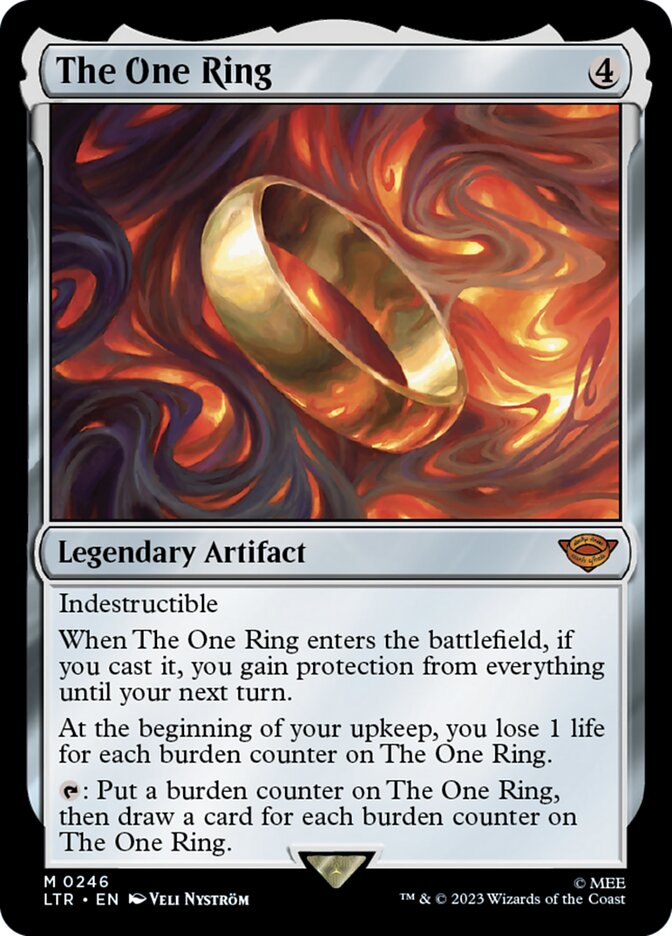
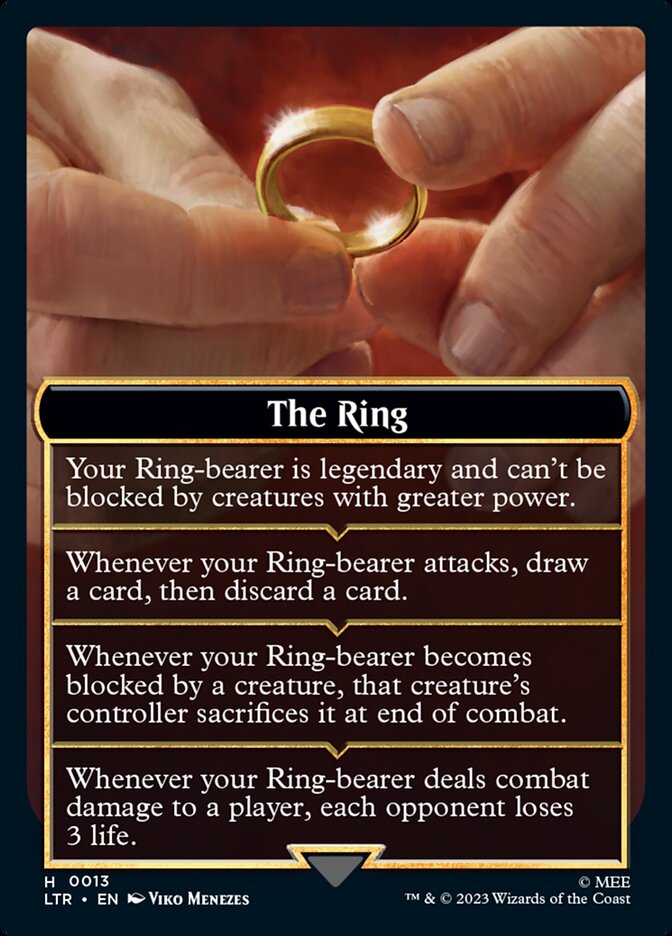
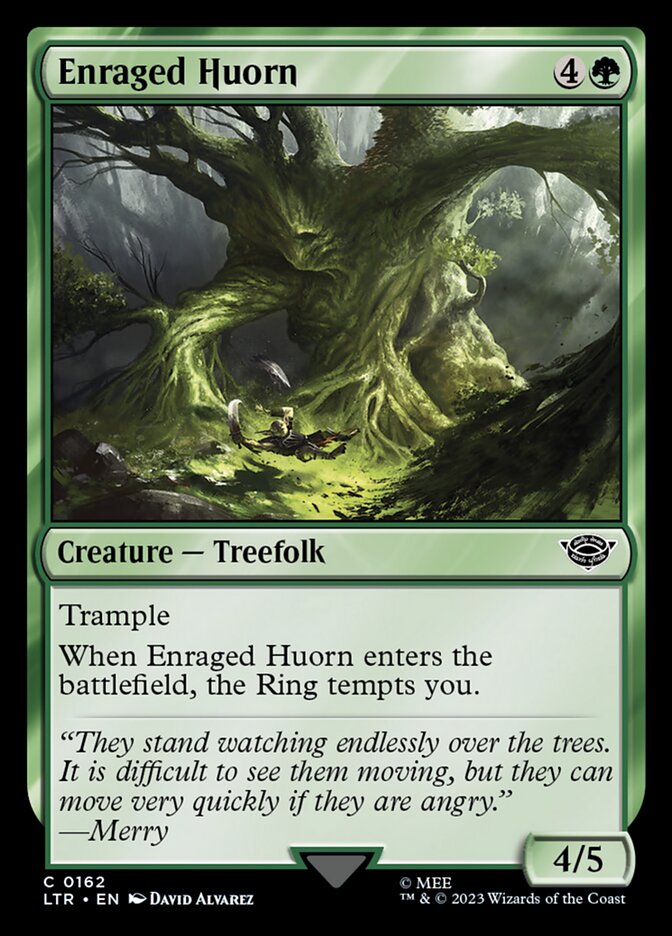

This is the big mechanic of LTR: the Ring. Perhaps it feels less unique because, well, every player can have one, and it can never be destroyed or taken away. But on the flip side - every player has a Ring, and yours can never be destroyed or taken away. It will grant you abilities. It will grant you power. And perhaps it will win you the game.
Here’s how the Ring works. There are cards - such as Enraged Huorn or Slip on the Ring - with the text “the Ring tempts you”. Each time the ability resolves, you use The Ring emblem to mark how many times it’s resolved, and how many abilities the Ring has gained. You also choose a creature you control to become your Ring-bearer (if you have a creature available).
The Ring-bearer gains a host of abilities that can swing the game in your favor. But on the flip side, it also instantly becomes a huge target for your opponent.
Amass Orcs
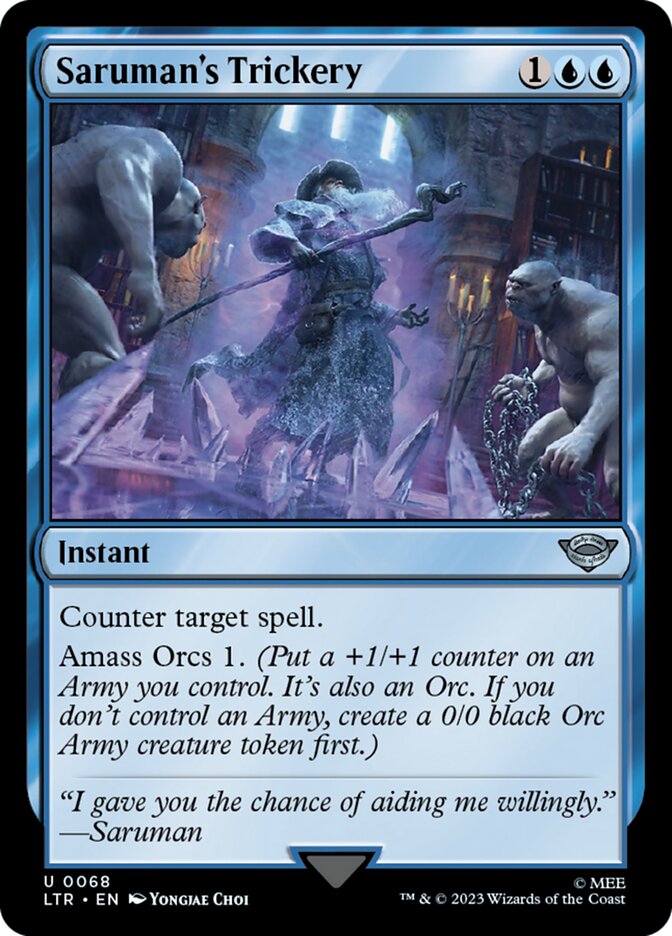
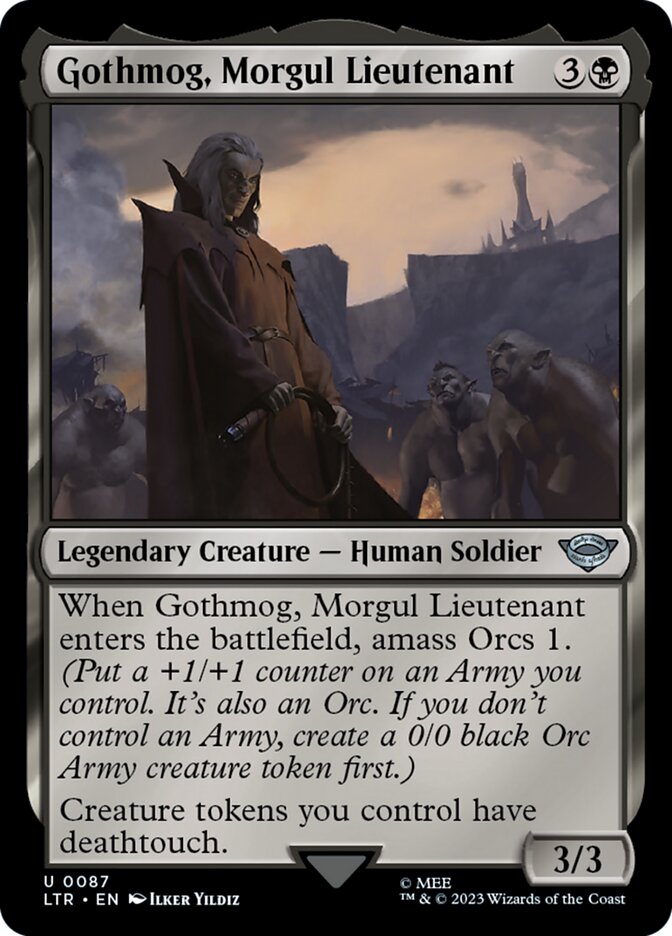
The first time I watched a trailer for The Two Towers, my jaw dropped as I witnessed the gigantic horde of orcs coming together for an assault on Helm’s Deep. LTR evokes such moments with the Amass Orcs mechanic, a variation of the Amass mechanic from War of the Spark. Amass Orcs X means the following: if you do not control an Orc Army token, create one and put X +1/+1 counters on it. Otherwise, take your existing Orc Army token and give it X additional +1/+1 counters.
Amass Orcs is present on a variety of card types. Gothmog, Morgul Lieutenant simply Amasses when it enters the battlefield. On the other hand, Saruman’s Trickery has Amass Orcs stapled to a counterspell, effectively allowing you to Amass at instant speed. This, of course, leads to the possibility of deceit as an Orc Army pops into existence out of nowhere.
This mechanic is present in Blue, Black, and Red.
Legendary (and Historic)
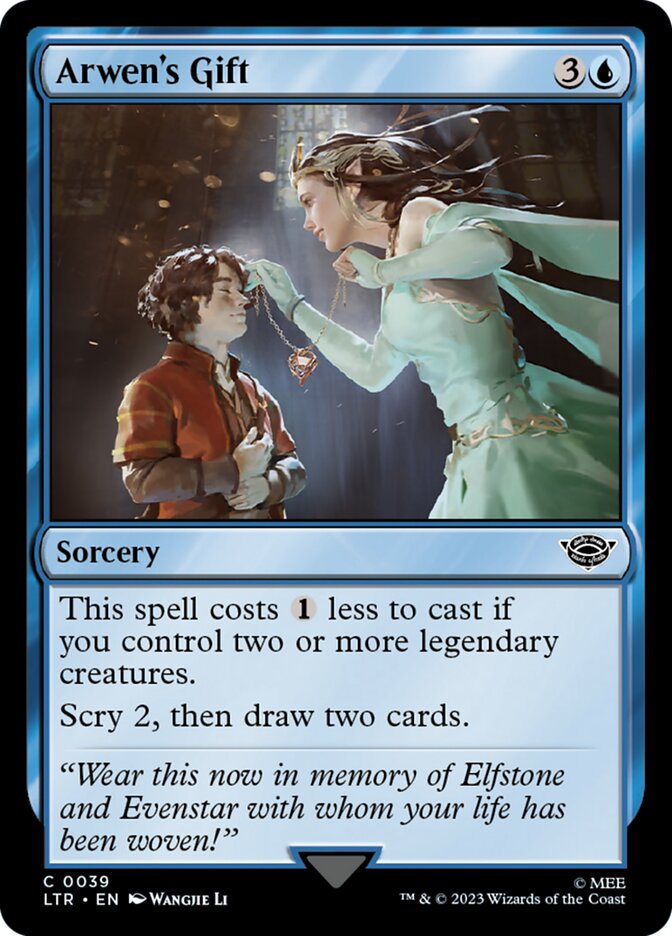
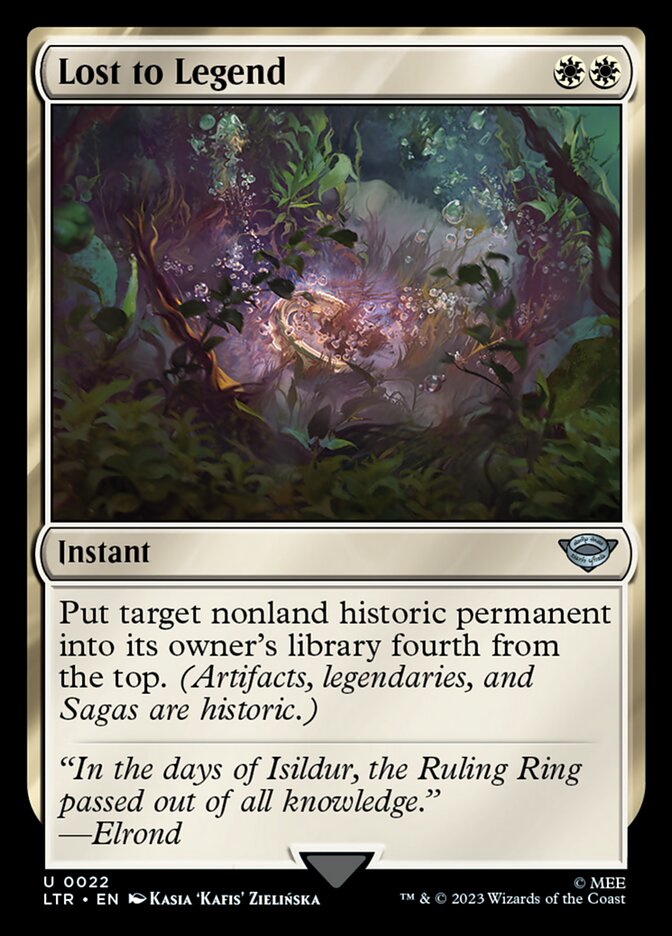
Lord of the Rings is full of colorful characters, each distinct and memorable in their own way. It makes sense that LTR would give additional emphasis to these legendary heroes and villains and weapons. It does so with cards that care about legendaries. For example, Arwen’s Gift is a draw spell that becomes cheaper if you control two or more legendary creatures. LTR also has a few cards such as Lost to Legend that reference Historic cards: not only legendaries, but also artifacts and Sagas.
Food

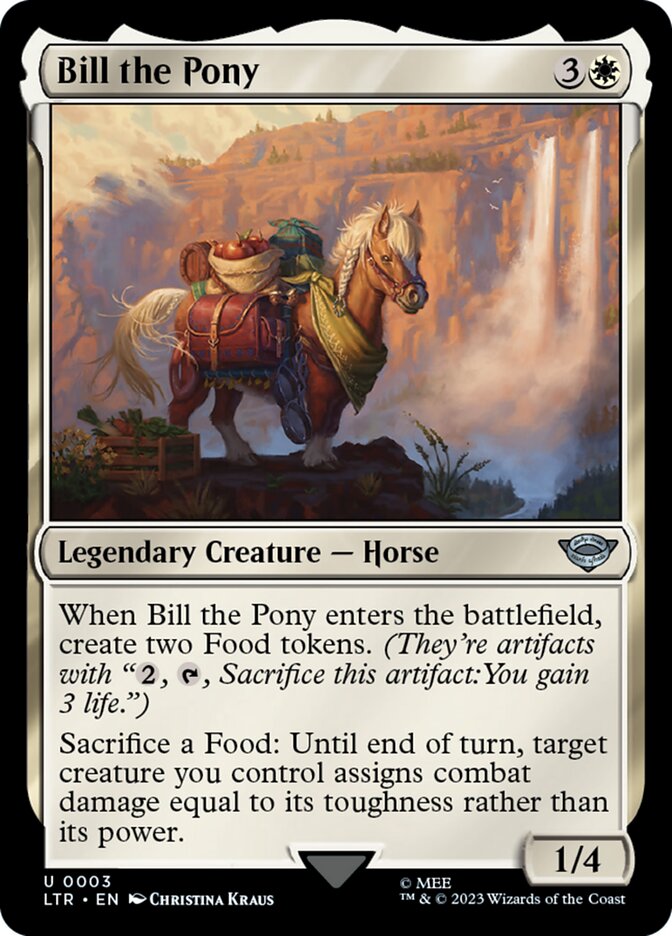
Food returns, and it’s no surprise. Various spells and effects create Food tokens, and these tokens can be used in a variety of ways. The one written on the token is life gain. But cards such as Peregrin Took and Bill the Pony allow you to sacrifice Food tokens for other powerful effects, encouraging to stockpile Food and expend them at just the right moment.
The colors that produce and care about Food are Green, White, and Black.
Tribal Cards
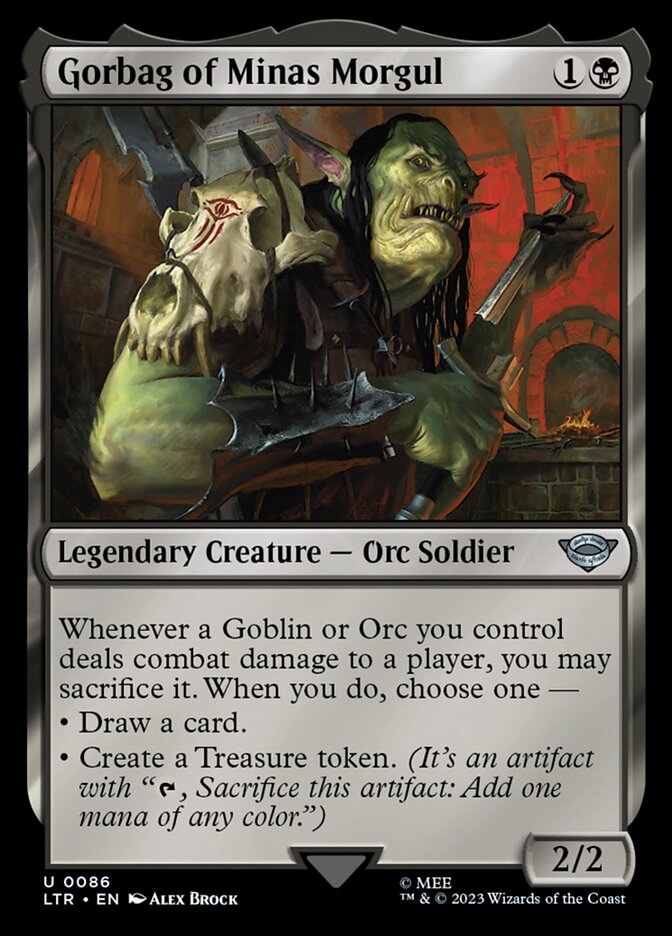
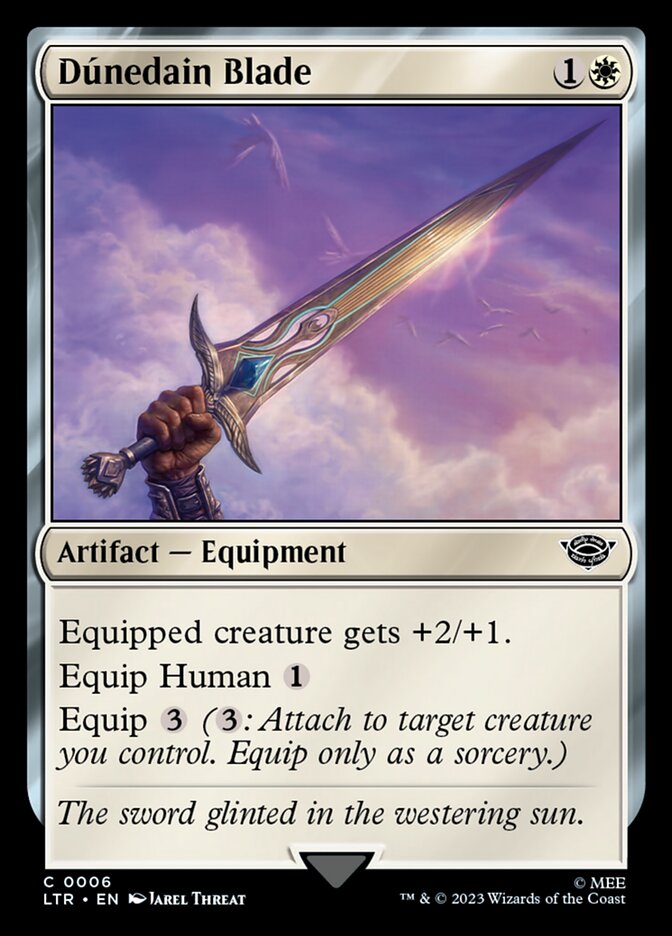
Although there aren’t a ton of cards that care about creature types, there are enough that it’s worth taking notice. And while cards such as Gorbag of Minas Morgul and Rally at the Hornburg won’t tempt me to make an all Goblin/Orc or Human deck, they’re enough to cause me to lean in that direction at the very least.
Archetypes
Ten color pairs, ten archetypes, and two signpost uncommons for each archetype (although one uncommon may be more signpost-y than the other).
White/Blue: Draw Two
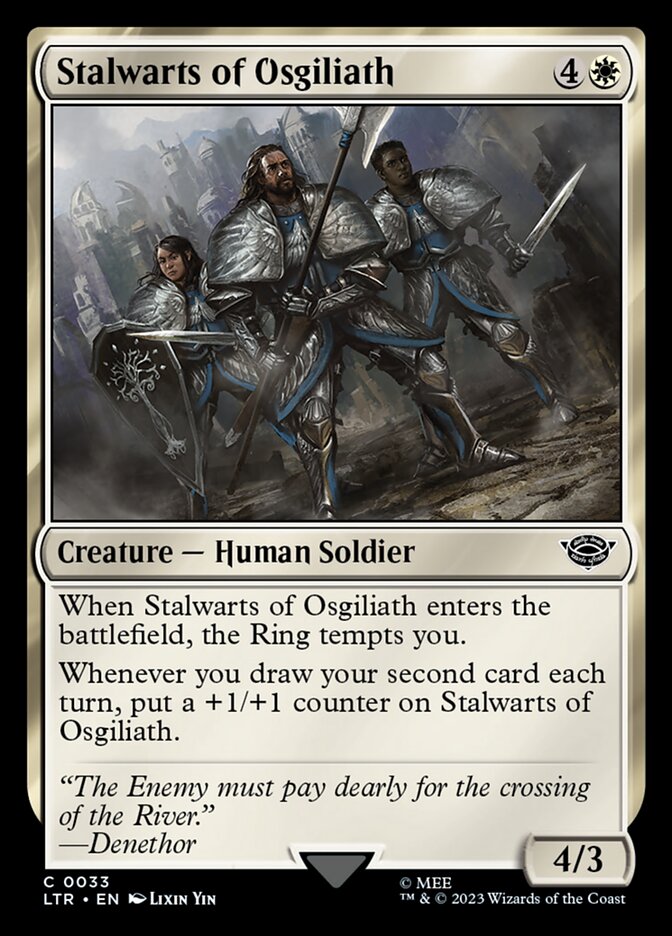
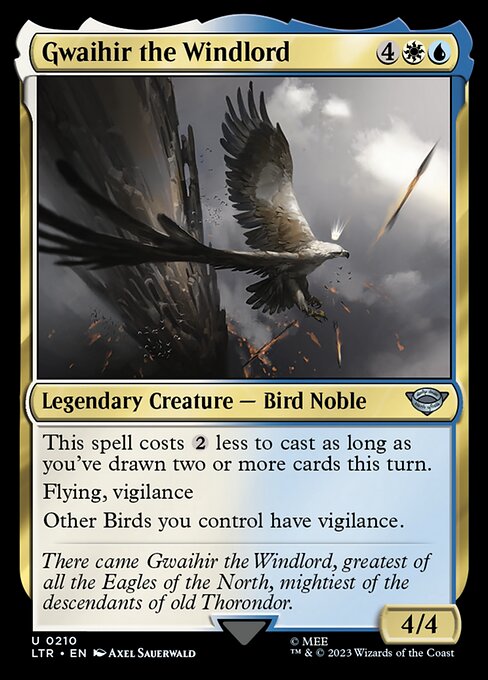
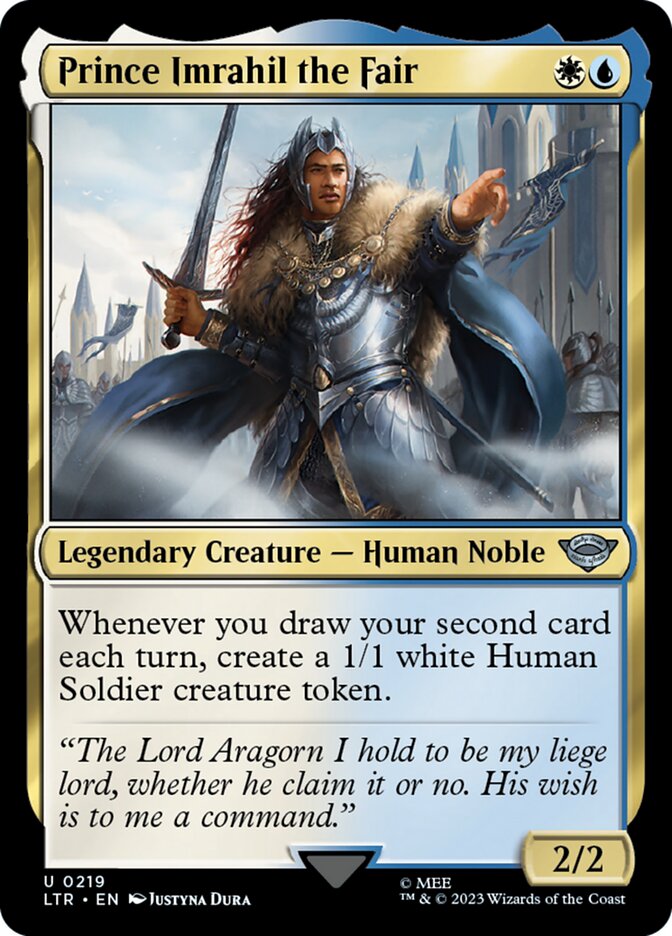
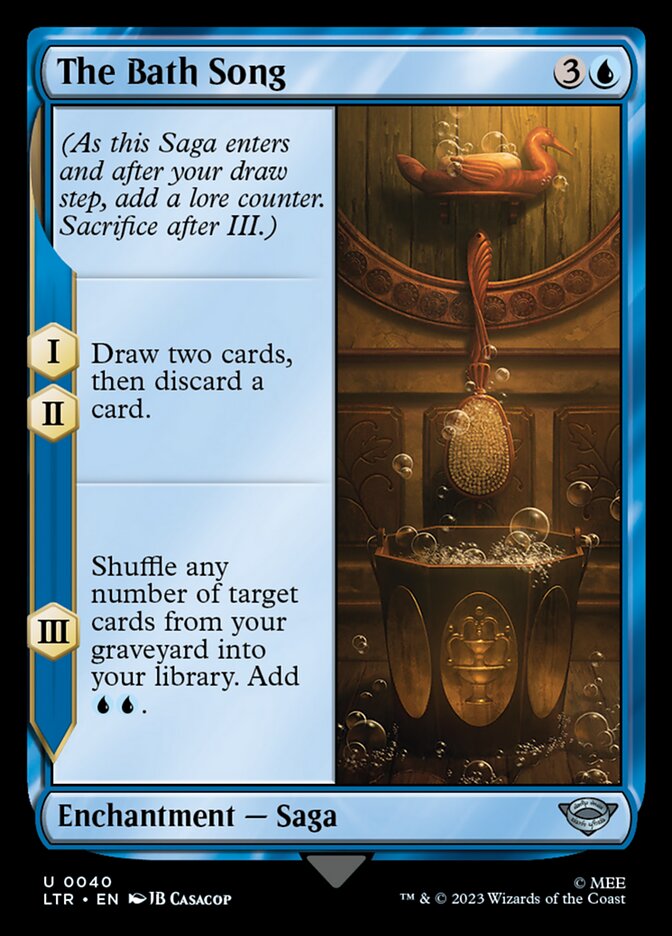
Experienced Magic players know that drawing cards is just about the best thing to do. Taking a turn off from playing to the board can be fatal however, so sometimes it’s nice to get an added benefit for refilling your hand. White/Blue’s two signpost uncommons illustrate two different bonuses: Prince Imrahil is a cheap two drop that can create a steady supply of creatures, while Gawihir the Windlord turns from a reasonable six mana flier to a four mana threat that an opponent must quickly kill. But how do you draw two consistently? Well, one way is to use a Saga like The Bath Song, whose second chapter not only draws you your second (and third) card, but also leaves up your mana for further shenanigans. Stalwarts of Osgiliath also lets you draw a second card (and benefits when you do so), albeit in a more roundabout way: if the Ring tempts you twice, then your Ring-bearer will loot whenever it attacks.
White/Black: Token Sacrifice
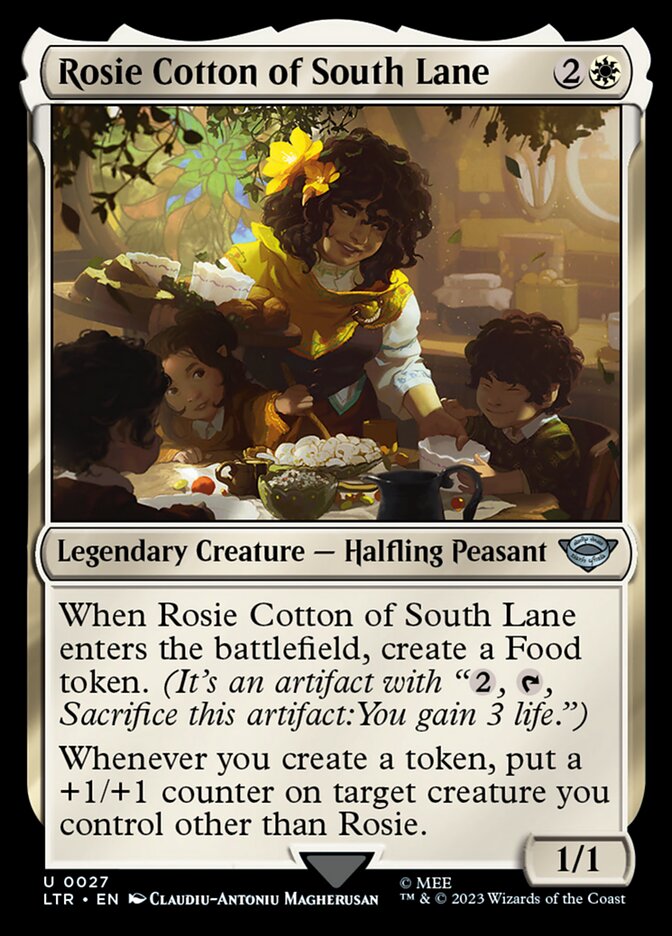
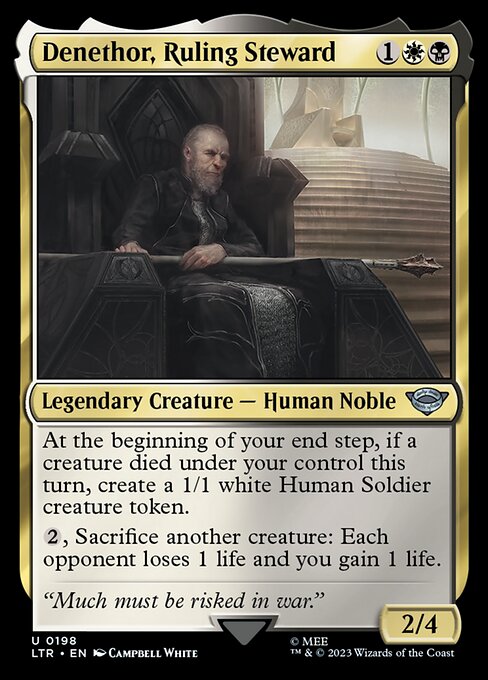

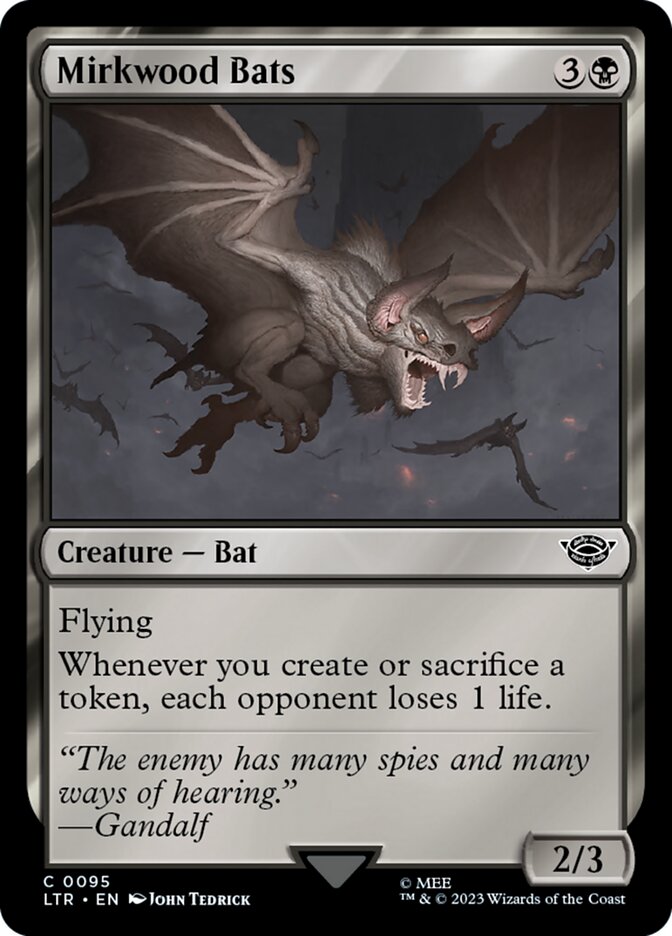
The cost of life is death, or so White/Black believes. This archetype plays a slow, stubborn strategy, clogging the board with creatures and chipping in for damage until inevitability takes over and your opponent understands that they’re dead. Denethor, Ruling Steward epitomizes the desired gameplay: sacrifice a creature - perhaps an attacker blocked by a bigger defender - in order to drain your opponent and create another piece of fodder on your end step. Throw in some Mirkwood Bats and the loop becomes even deadlier; or throw in Rosie Cotton of South Lane and gain a different sort of reward. Of course you run the risk of running out of sacrificial lambs. Fortunately Shadow Summoning gives you two easy replacements that also gives you some evasive threats.
Blue/Black: Amass (Control)

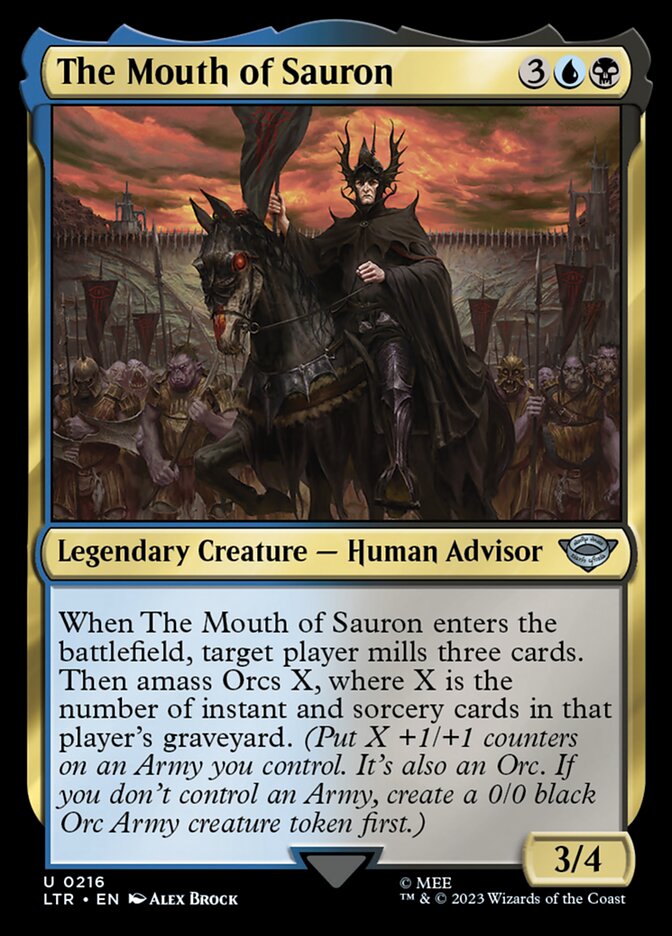

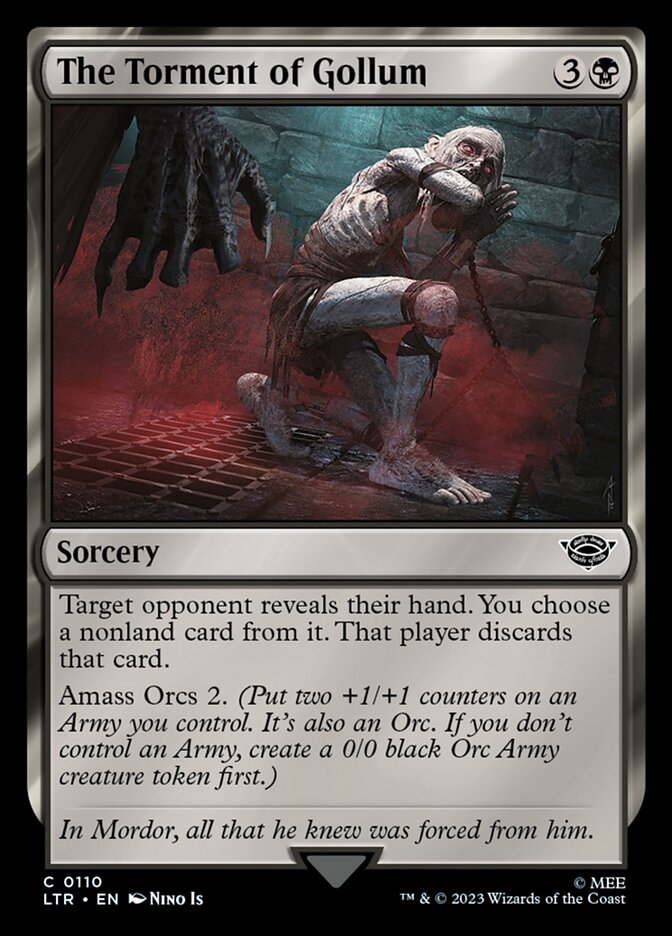
How does a control deck use Amass? By stapling the effect onto instants and sorceries that deal with your opponent’s threats while creating one of your own. Of course, a Limited deck is unlikely to play full control, which is where The Mouth of Sauron comes in: play your instants and sorceries first, and then slam him down to create a giant army. There are other facets of a control deck, namely the ability to find the right answer for your opponent’s board. Ringsight is ideal for this, allowing you to potentially search your entire deck for a removal spell or one-of bomb. And then there’s the ability to rebuy your removal spells - Treason of Isengard - and to destroy your opponent’s hand - The Torment of Gollum - both of which come with an Orc Army ready to grind your opponent to dust.
Blue/Red: Instants and Sorceries Matter
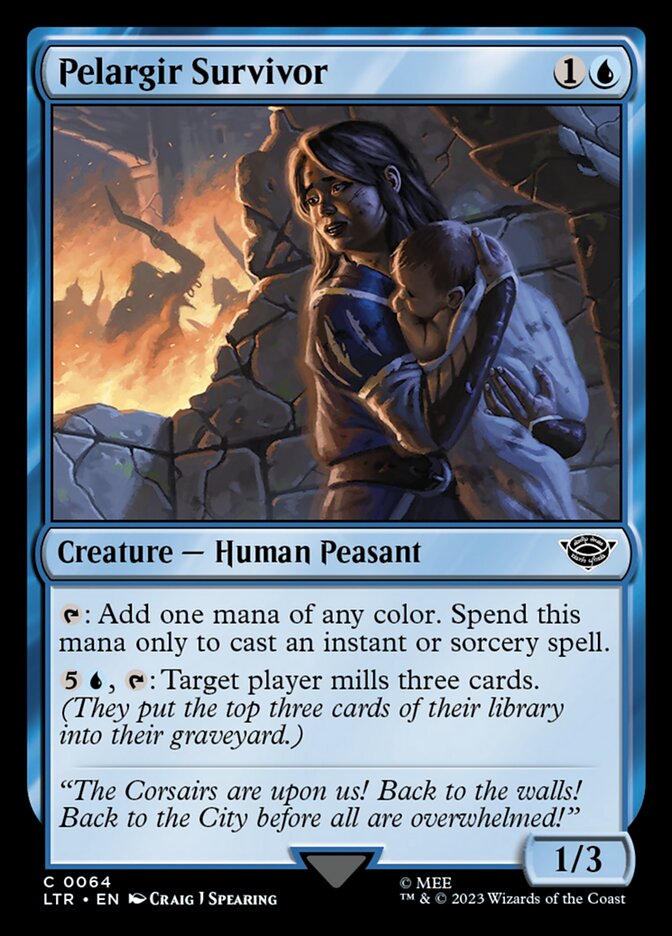
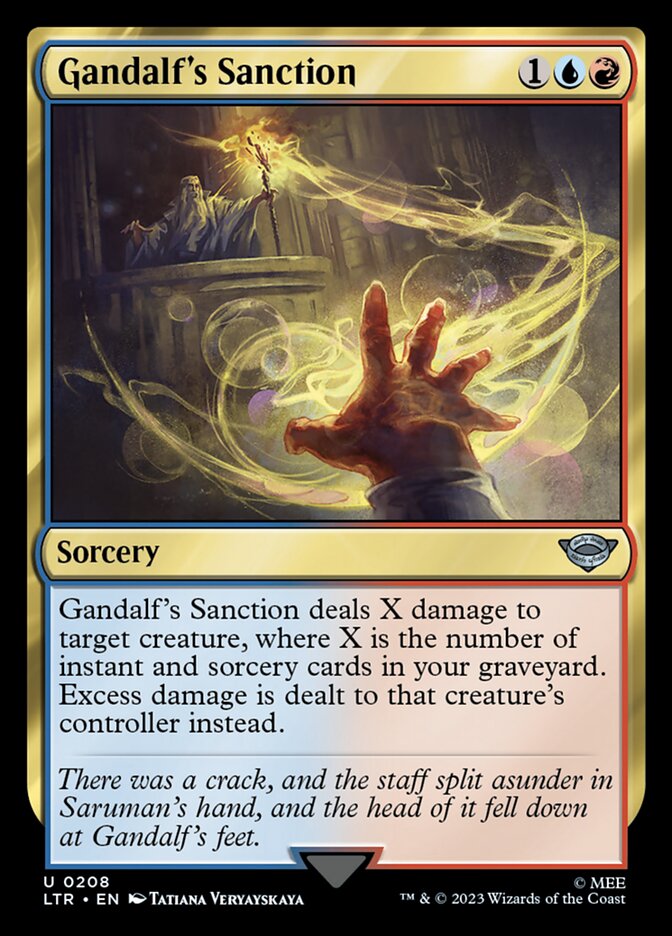

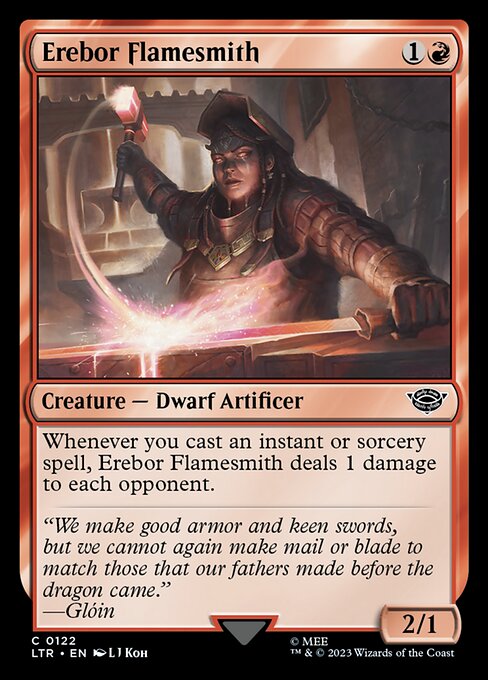
Here is Blue and here is Red and together they form another Instants-and-Sorceries-matter theme. Gandalf’s Sanction may feel like it will do laughably little, but players experienced with this archetype know that it can inflict a truly absurd amount of damage - even enough to one shot your opponent - as long as you put the right cards in your deck. Erebor Flamesmith can give you a lot of additional incidental damage along the way, and Pelargir Survivor will help you cast your instants and sorceries while also giving you the opportunity to quickly stock your graveyard. How does Bilbo, Retired Burglar fits into this archetype? At first blush: not at all. But keep in mind that in LTR, Blue/Red is a control archetype, and Bilbo truly is a perfect fit: an evasive threat (as a Ring-bearer) that also gives you extra mana to cast your spells.
Black/Red: Amass (Aggro)
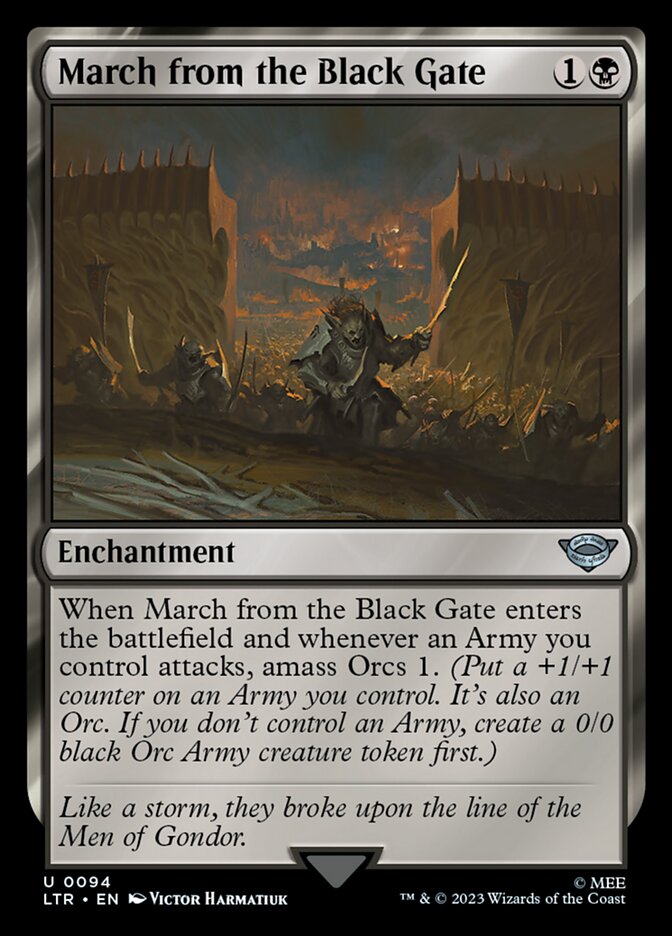
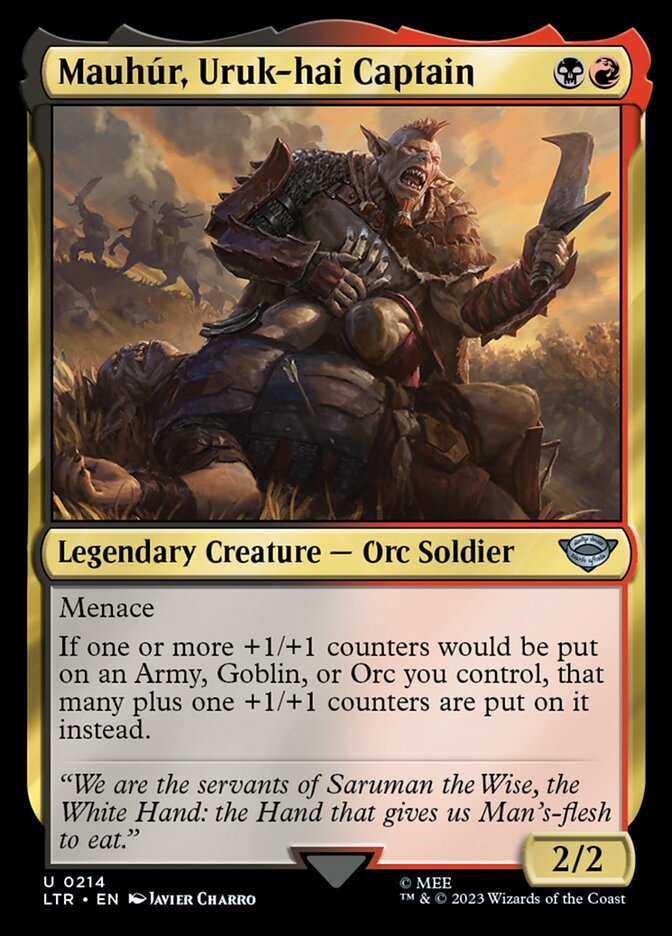

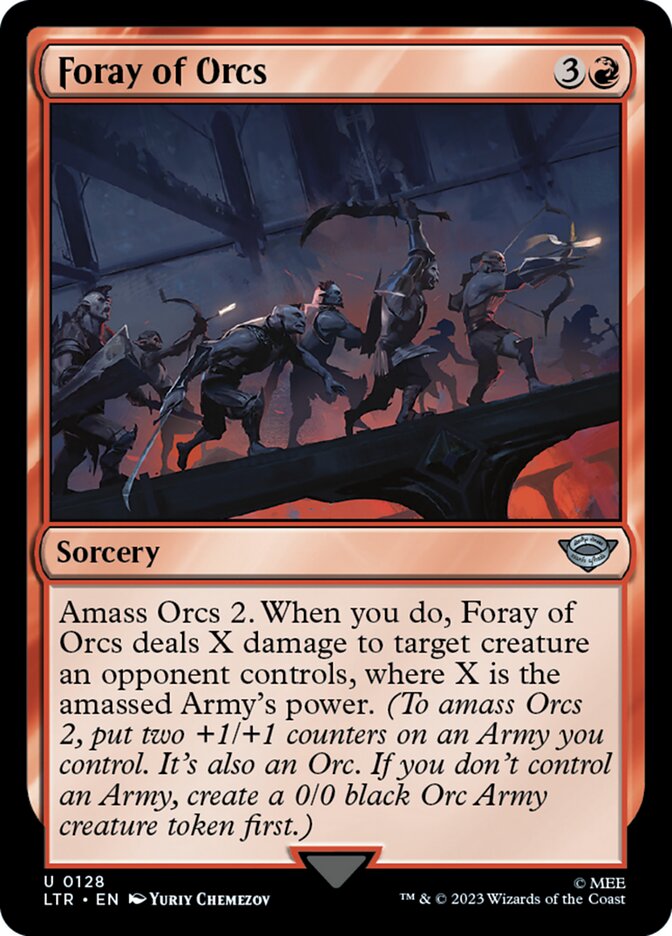
We’ve seen how a control deck might use Amass; now let’s see how an aggro deck uses it. The answer is simple: use cards like Mauhúr, Uruk-hai Captain to make your Orc Army bigger and bigger and bigger. Of course an aggressive strategy is likely to result in fatalities on your side, which is where Uglúk of the White Hand comes in: let your cannon fodder die in order to buff him to ridiculous levels. To round out your deck, use March from the Black Gate to ensure that you’ll always have an Orc Army in play; and Foray of Orcs to enable you to take out blockers while your Army grows to greater heights.
Black/Green: Midrange Sacrifice


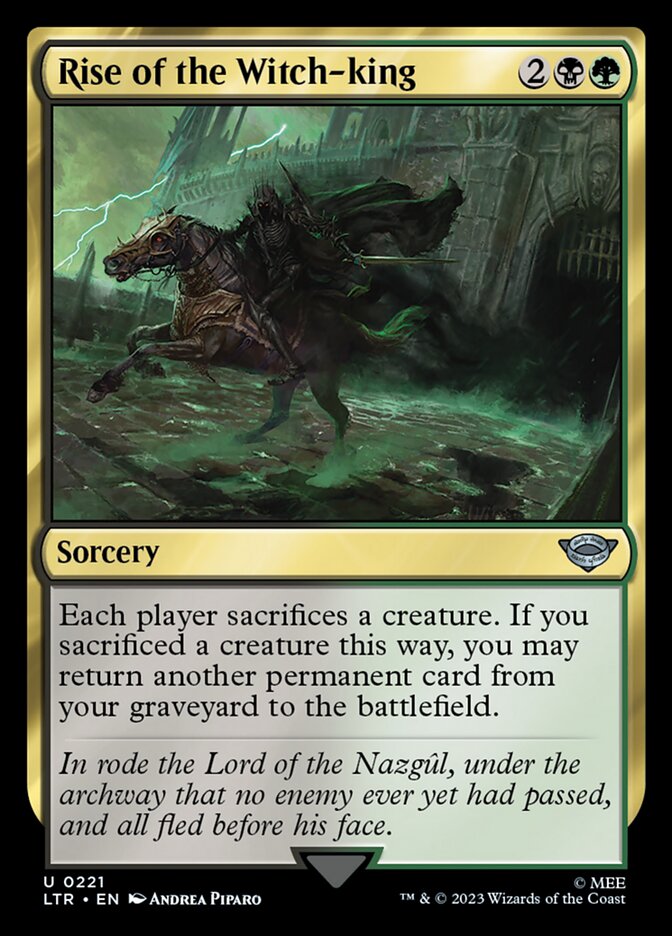
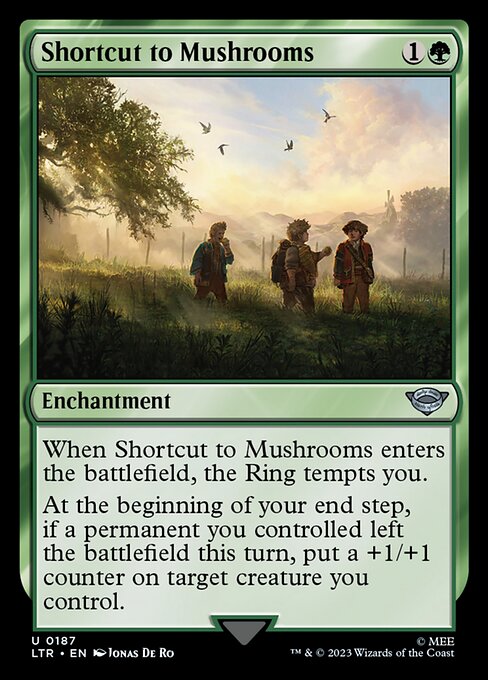
The first half of Old Man Willow makes it clear that Black/Green plays towards the long game with lots of lands; the second half makes it clear that there’s a sacrifice theme. So… yeah, just do that, and keep in mind that Food can both be sacrificed and be used to extend the game. Haunt of the Dead Marshes is an attractive piece of repeatable sacrifice bait (as long as you have the mana and legendary creature to reanimate it) and Shortcut to Mushrooms gives you an additional repeatable benefit to having your creatures and tokens leave the battlefield. Rise of the Witch-King adds another dimension: if you manage to discard an expensive permanent (perhaps by having the Ring tempt you twice), you can reanimate it for the relatively cheap price of four mana.
Red/White: Aggro
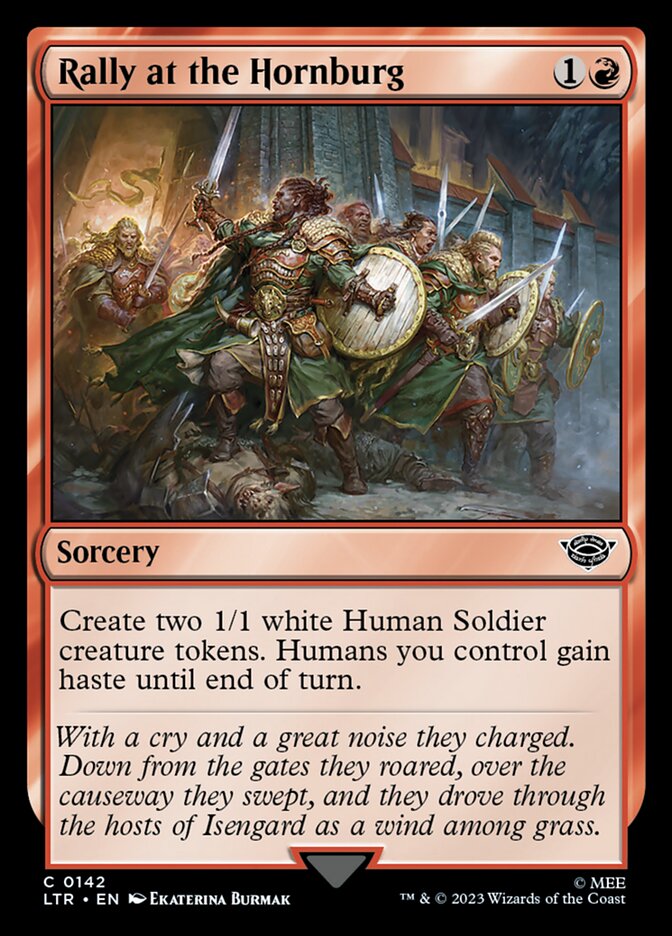

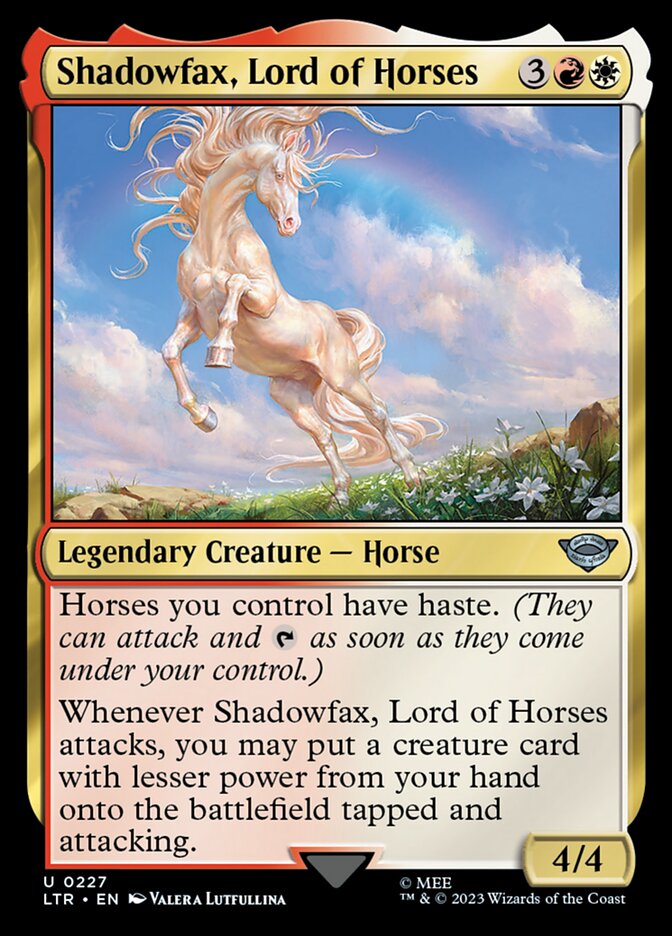
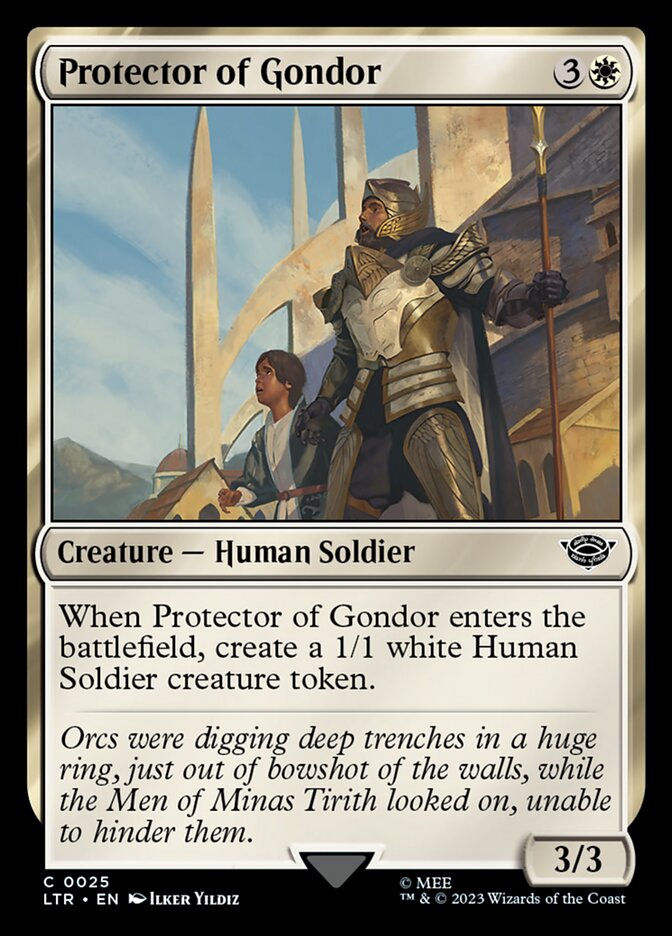
It can be difficult to distinguish between flavors of aggression: how does Red/White differ from Red/Black? Well, I’d say that this archetype is aggression dialed up to 11. Théoden, King of Rohan encourages you to play out your creatures for a nice buff that will likely force your opponent to make a hard choice between losing a defender or taking a fair chunk of damage; and Shadowfax, Lord of Horses has haste and allows you to dump out extra attackers at ridiculous speed. Throw in spells that dump out two creatures at a time - for example, Rally at the Horburg and Protector of Gondor - and your opponent will end up dead beneath a sea of bodies.
Red/Green:
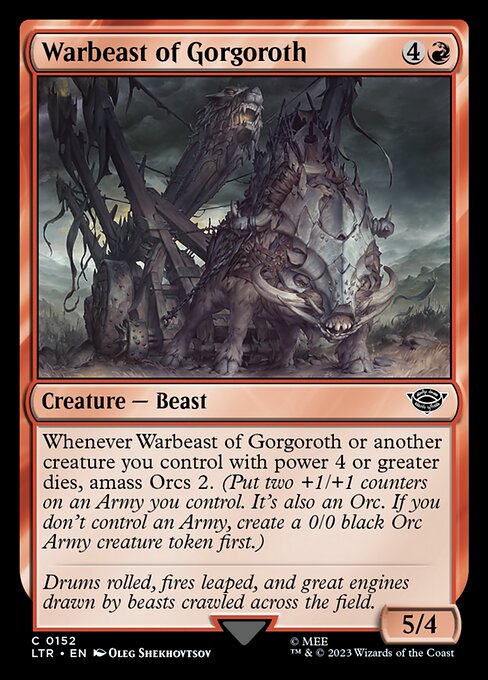



Sometimes a compromise is needed between Red’s aggressive nature and Green’s desire to ramp towards bigger creatures. Strider, Ranger of the North encapsulates this compromise: a chunky four drop whose Landfall ability likely allows you to attack freely. Warbeast of Gorgoroth ensures that you’ll retain some value even if your opponent destroys one of your powerful creatures; and Long List of the Ents is a cheap way to make some or many or all of your creatures just a little stronger with a +1/+1 counter that might be enough to turn the tide of combat These buffs are characteristic of this color pair, and allow you to use efficient removal spells such as Friendly Rivalry to clear the way for your beaters.
Green/White: Aggro Food
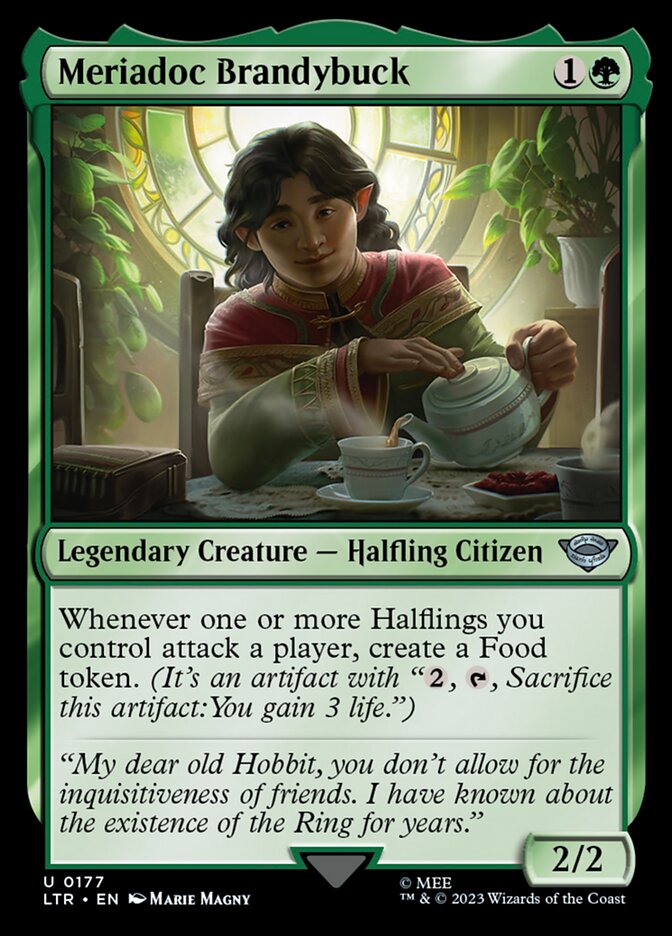
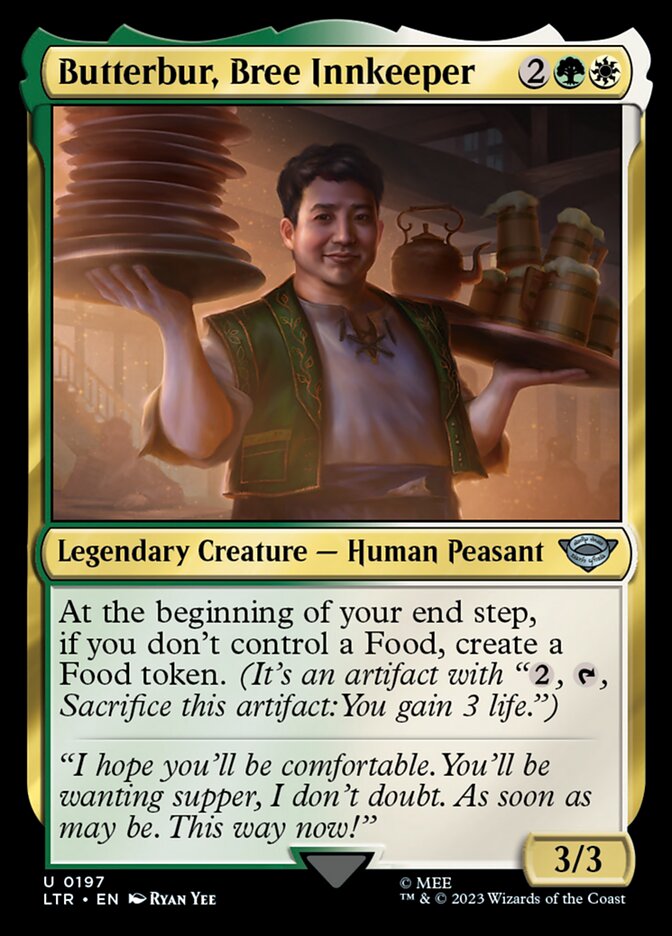
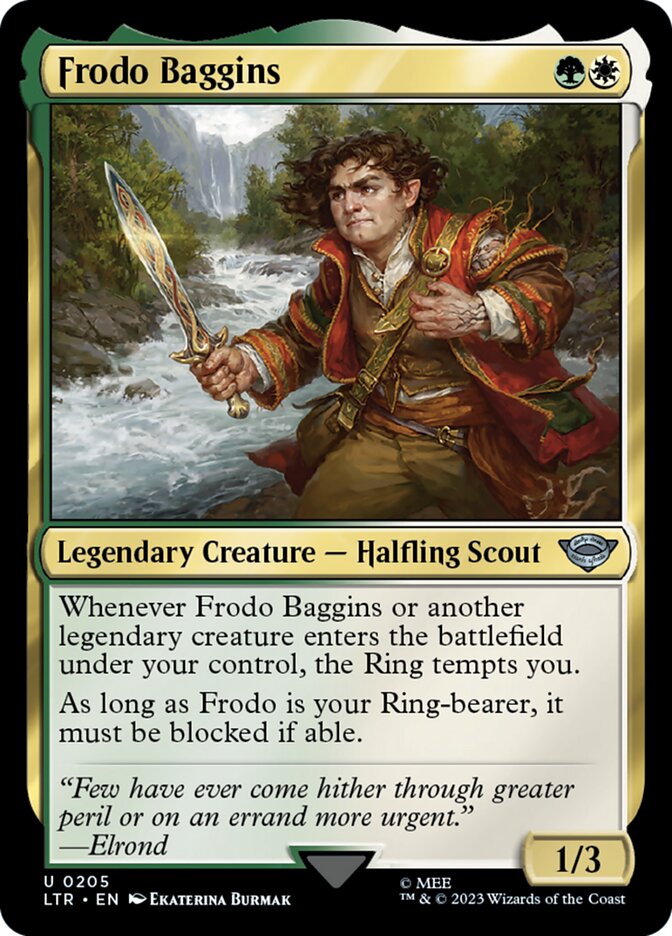
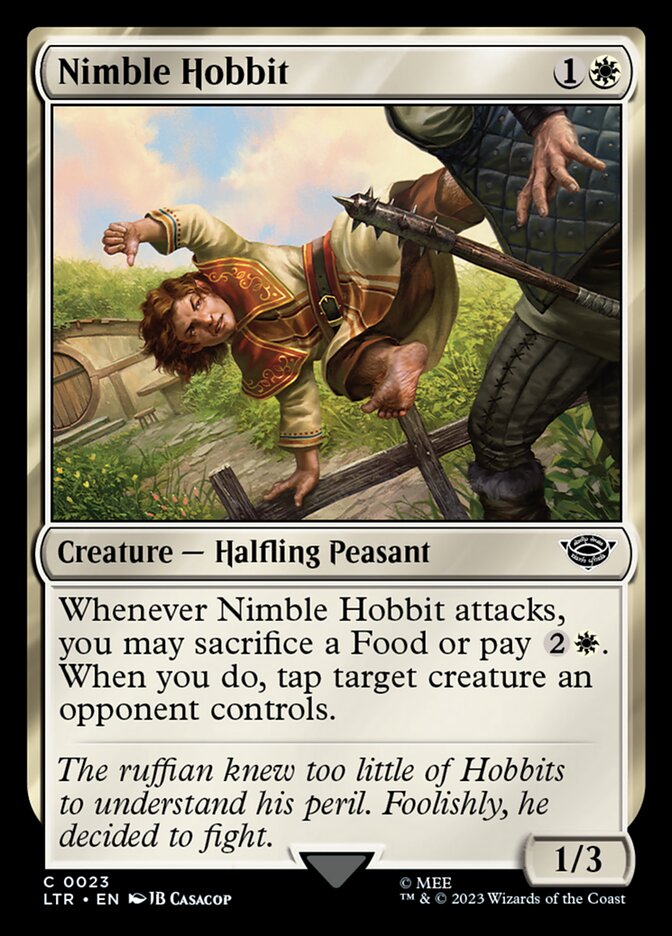
Green/White is the color of happy little hobbits munching on Food token - or sometimes using them for more aggressive purposes. It’s hard to keep up an effective flow of Food for these cards however, which is where Butterbur, Bree Innkeeper comes in: he won’t overserve you, but he’ll make sure you always have access to at least one Food. Meriadoc Brandybuck is another creature that can supply you with Food as long as your deck is built to attack, and Nimble Hobbit eases the way by using Food to tap potential blockers. This archetype can use a different tactical approach as well: Frodo Baggins may seem like a weak 1/3 creature, but his ability to allow you to quickly move along the Ring’s track should not be underestimated. After all, if he’s your Ring-bearer, he can only be blocked by one power creatures - and it’s likely that your opponent won’t have enough of those to stop him.
Green/Blue: Scry Matters
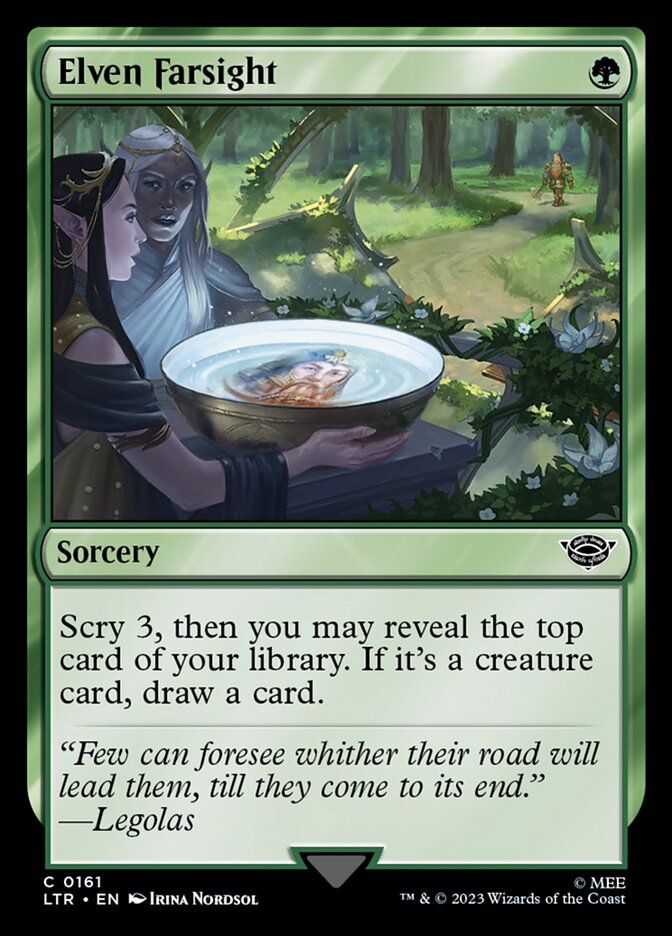

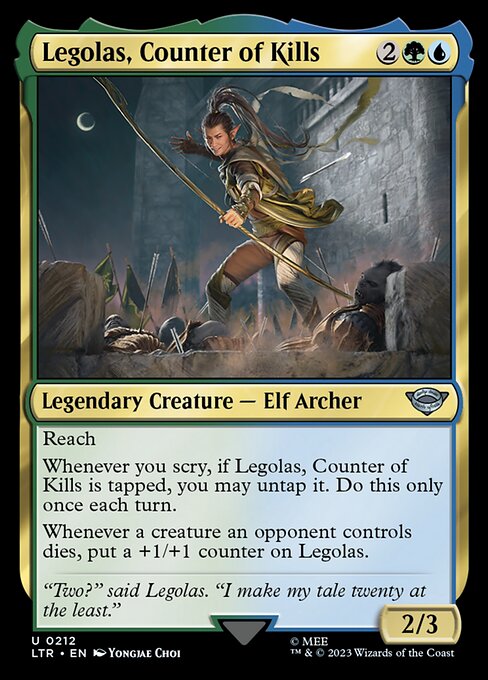

Caring about scry means that you are focused on the long-term, so don’t expect the Green/Blue archetype to be super aggressive. But there are tools to make sure you survive to the late game. Arwen Undómiel is a two drop who will gradually strengthen your creatures as you scry for the cards you need, and later on she is an effective mana sink that allows you to scry at will. Similarly, Legolas, Counter of Kills takes time to grow powerful, but his ability to suddenly untap makes him a frightening surprise blocker; and Nimrodel Watcher is an early two drop whose ability is a win condition all by itself. And how should you scry? There are a lot of options, but Elven Farsight is a cheap and attractive option.
Mana Fixing
How’s the colorless mana fixing? It’s not the best, but neither is it the worst:
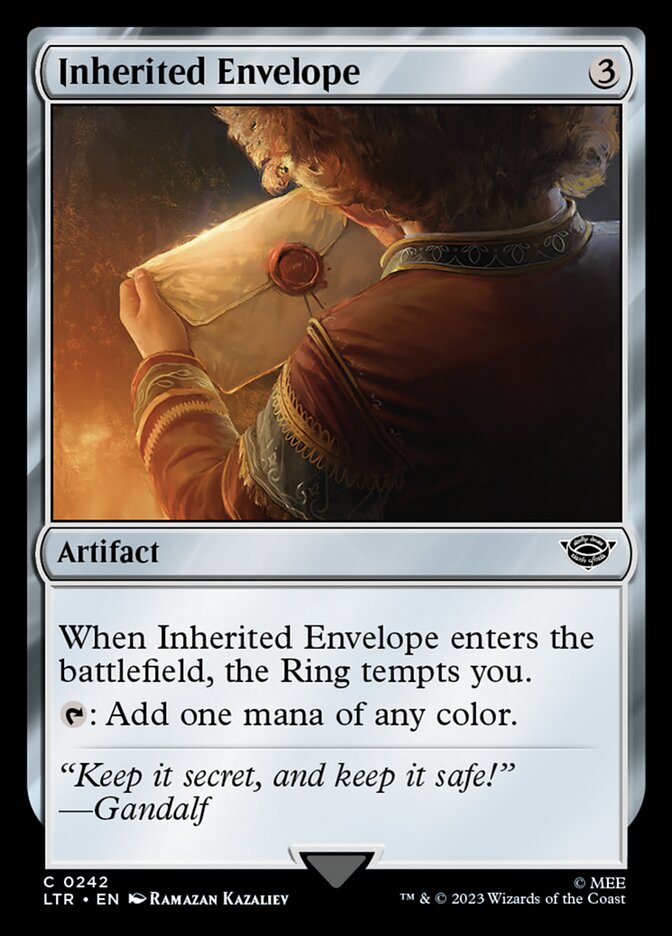
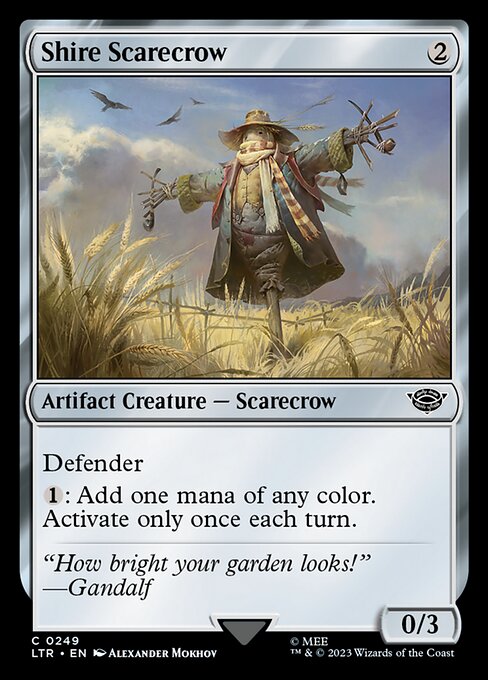
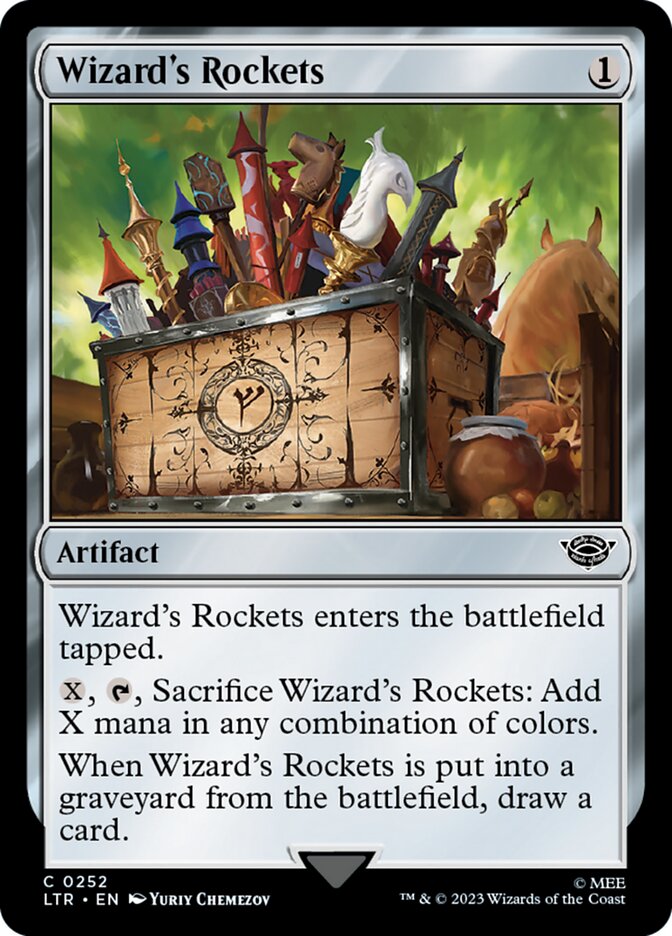
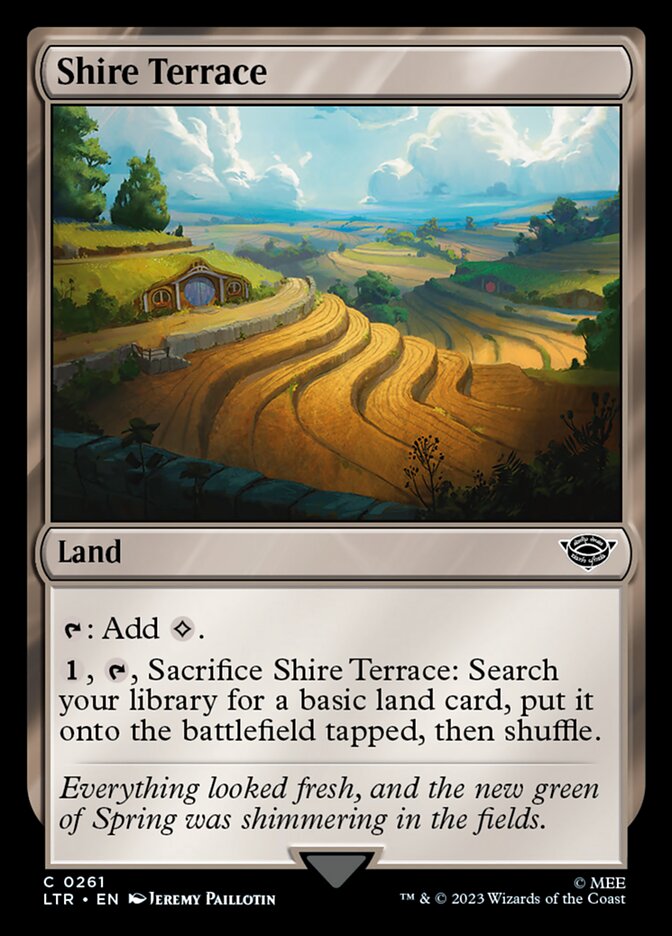
There are also two lands that have some interesting text regarding legendary creatures:
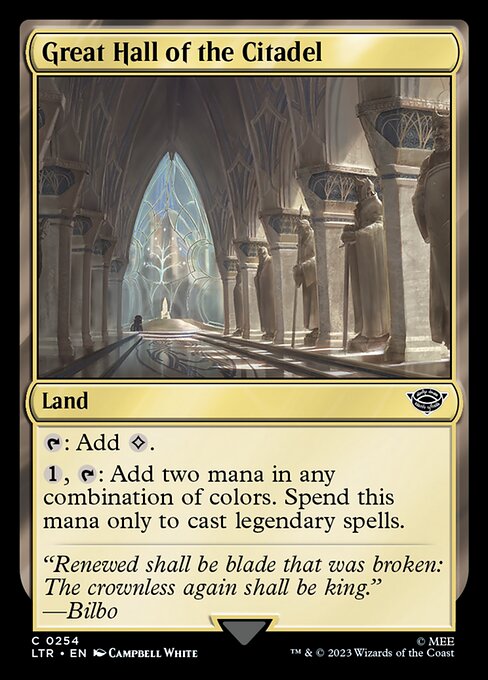
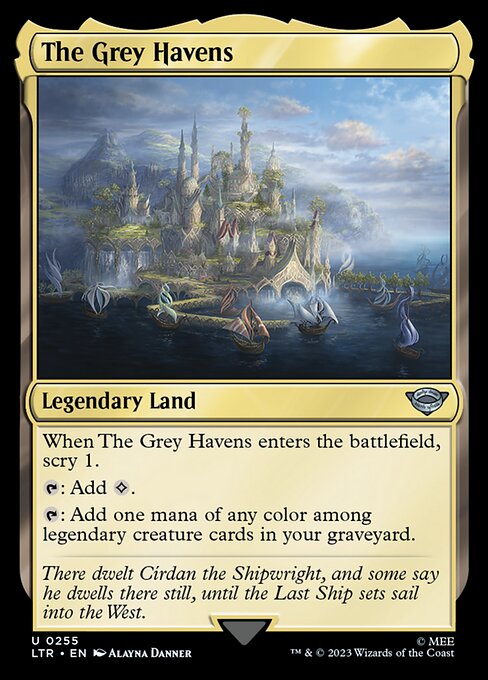
Naturally Green has additional options, each of which feels tailored to a particular Green archetype.
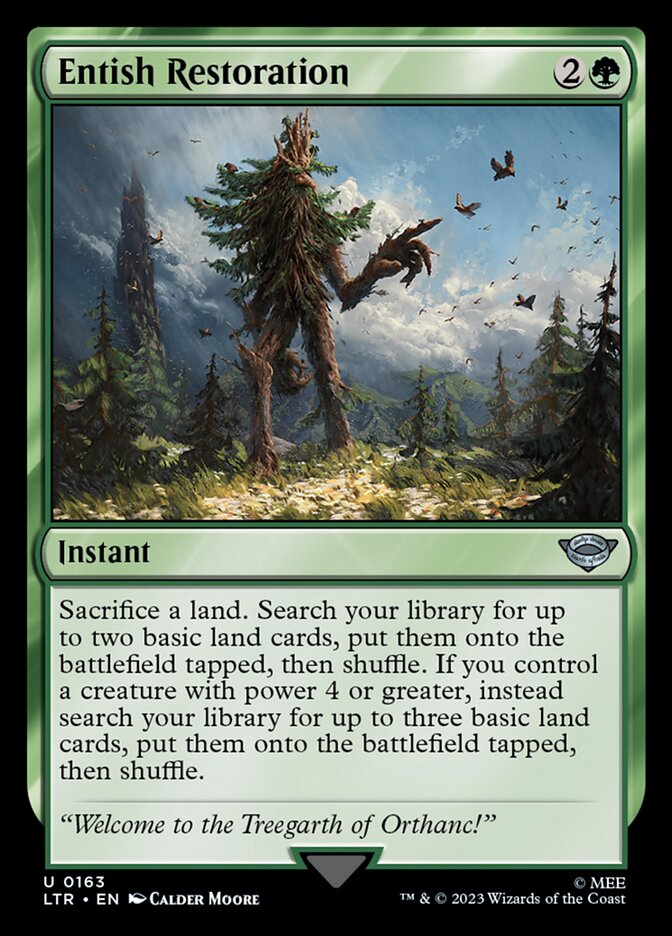
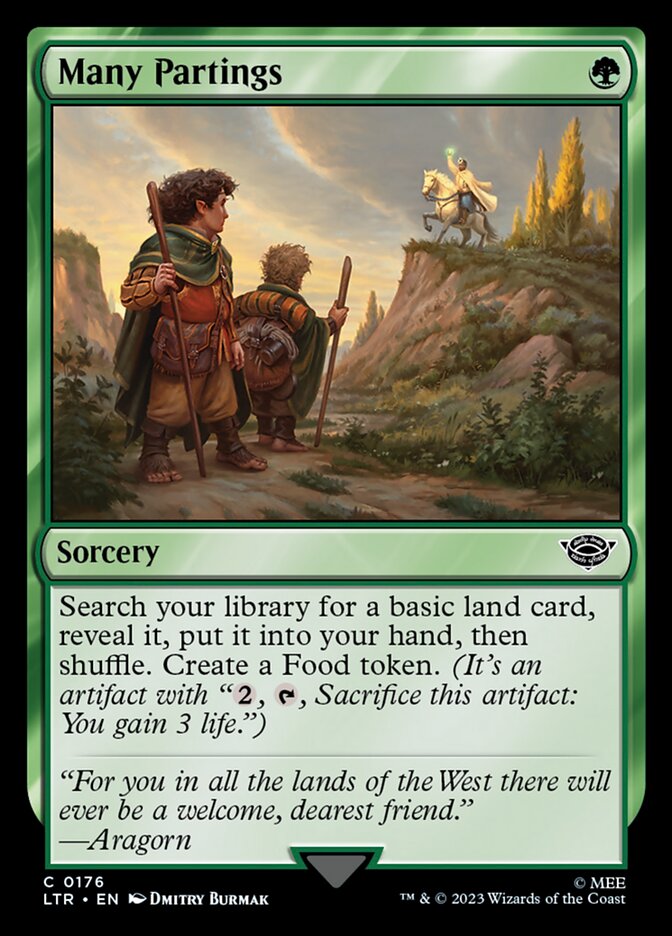
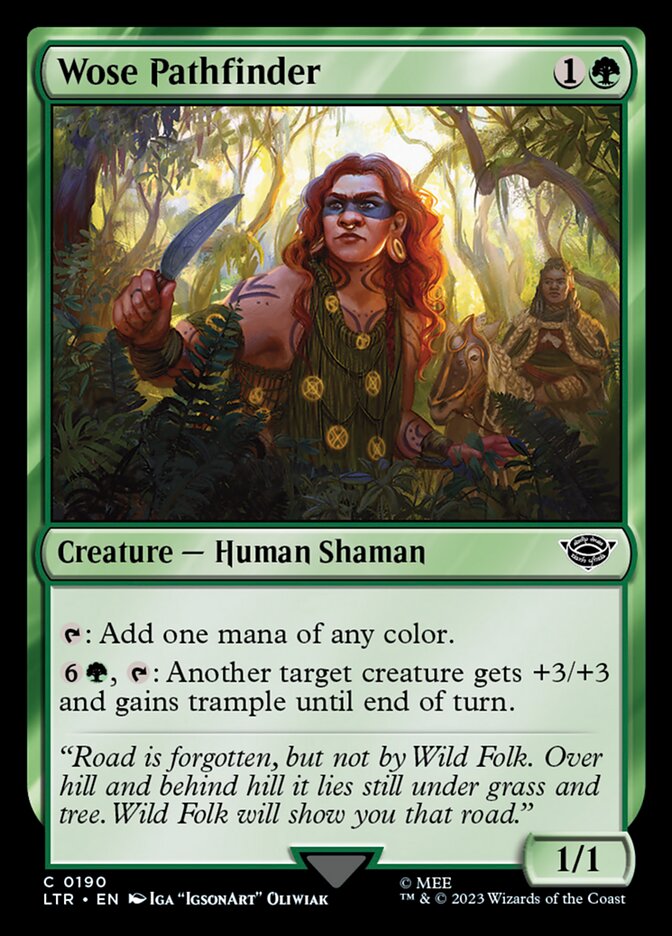
Finally, there’s a cycle of common basic land cyclers to help ease any splashes.
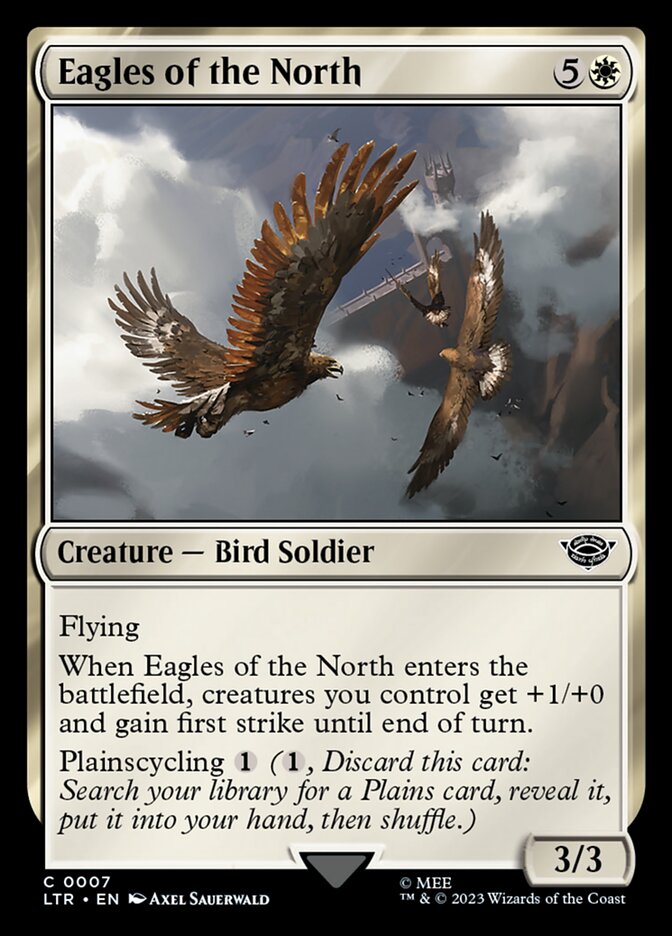
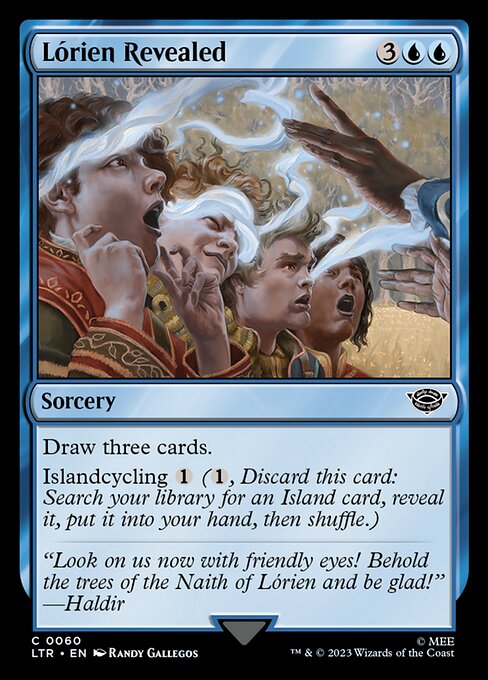
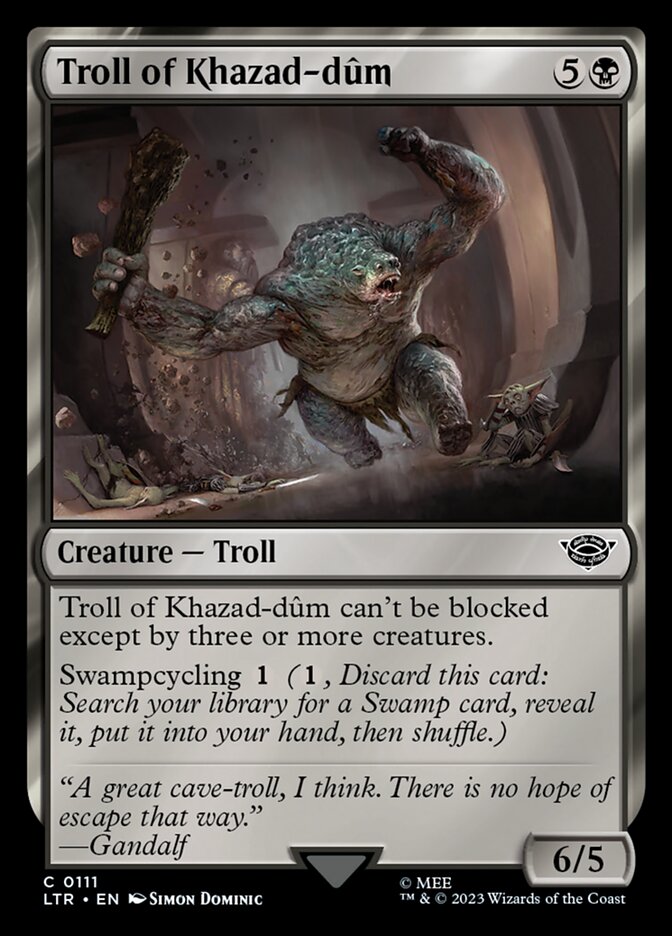
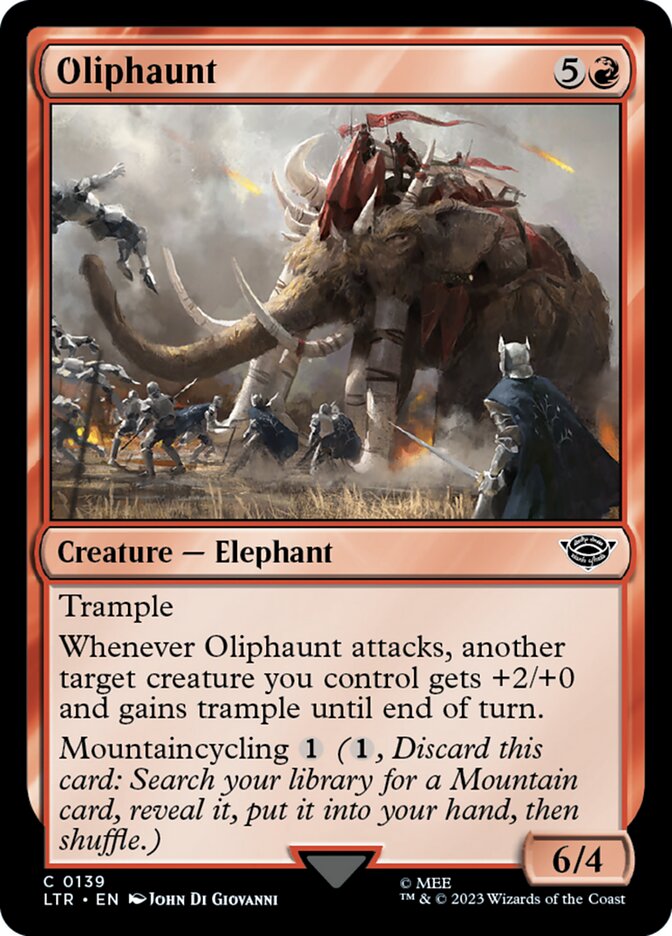
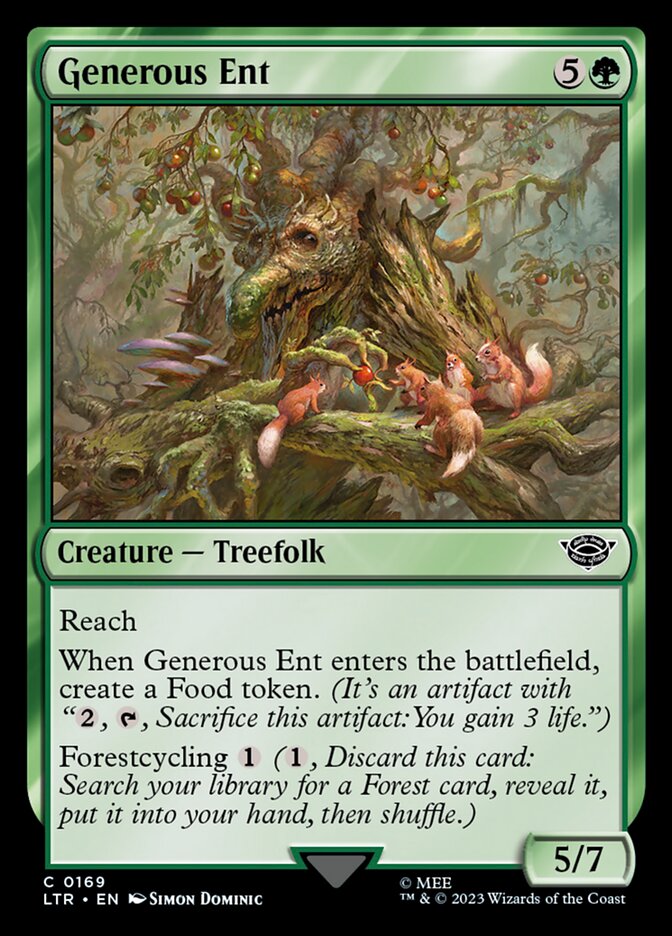
Key Commons and Uncommons
White
Creatures
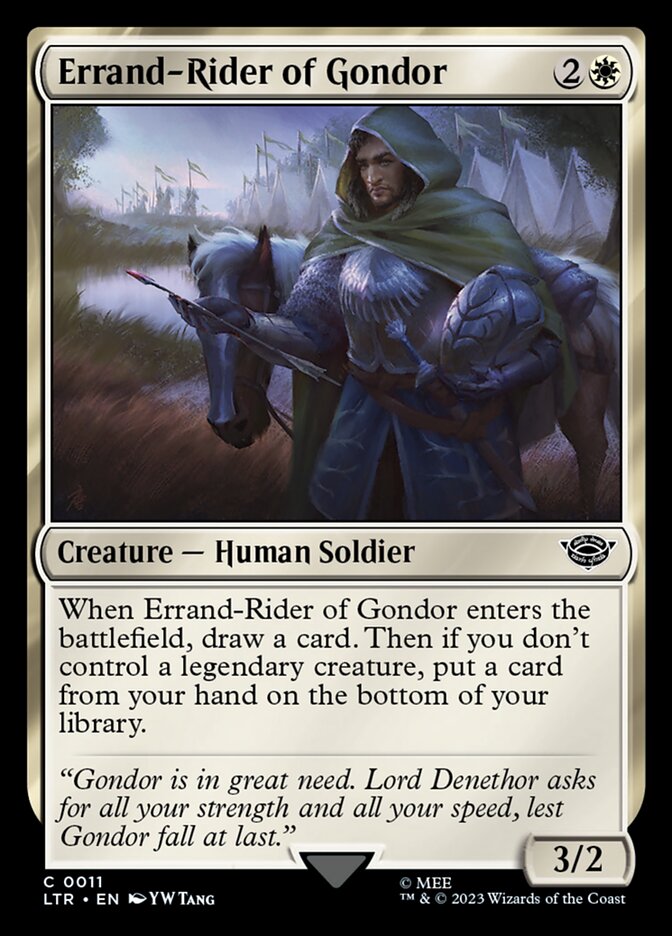
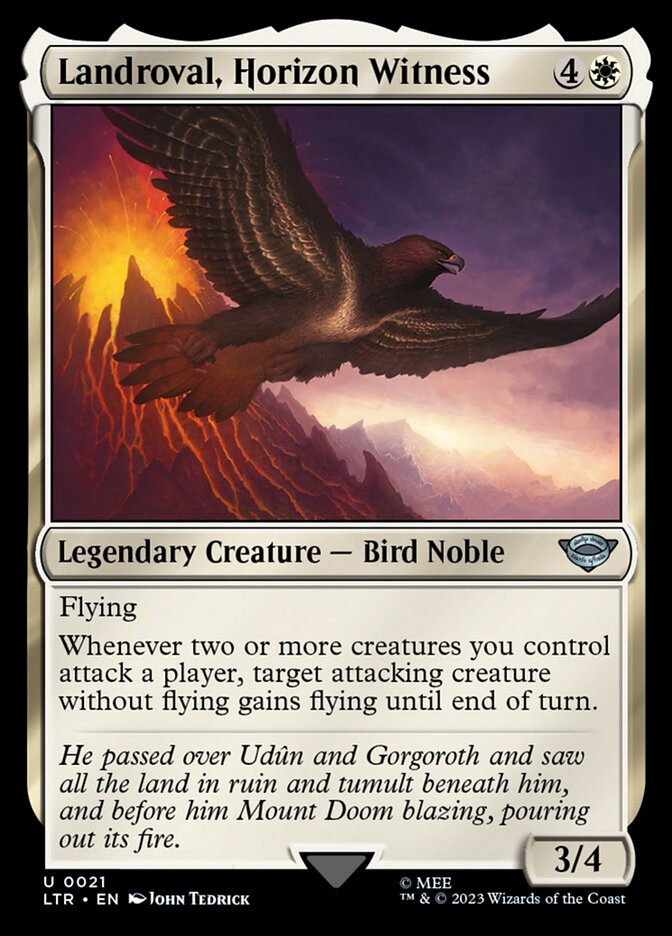
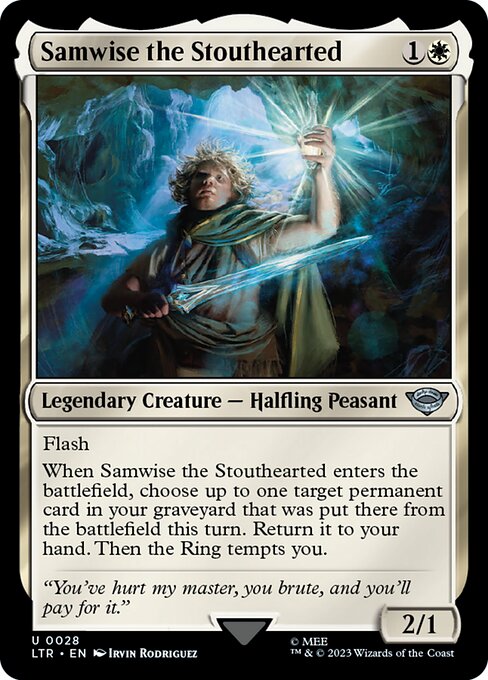
- Errand-Rider of Gondor: If you don’t control a Legendary creature, well, looting is fine. If you do control a Legendary creature, drawing a card is great. And this set has a lot of Legendary creatures.
- Landroval, Horizon Witness: This creature will end games quickly if your opponent is lacking reach or fliers of their own. It’s also great at taking a Ring-bearer wherever they’d like to go.
- Samwise the Stouthearted: It’s not hard to imagine this as a 2-for-1 that scales extremely well into the late game.
Non-Creatures
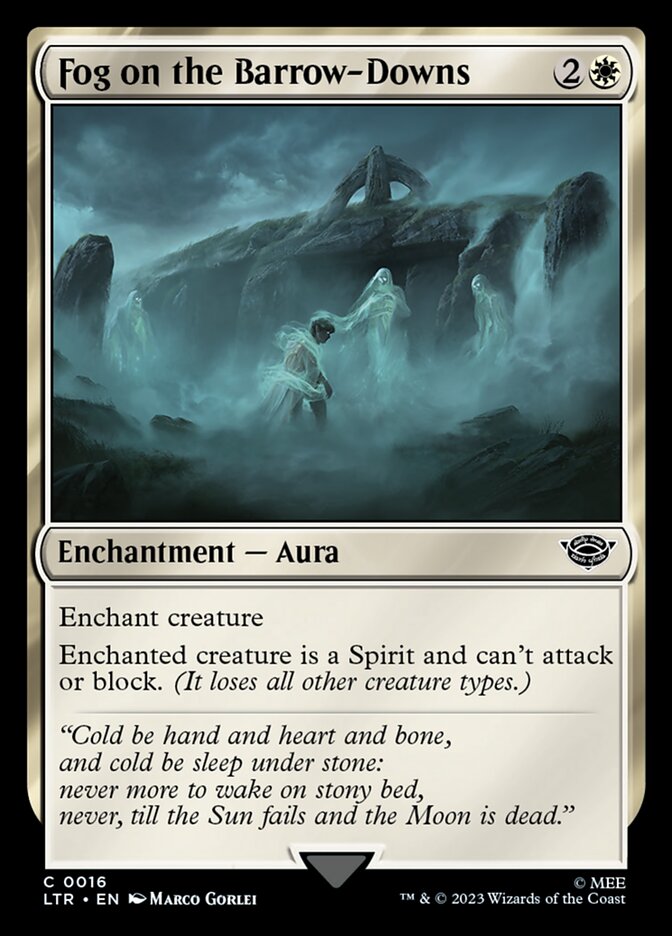
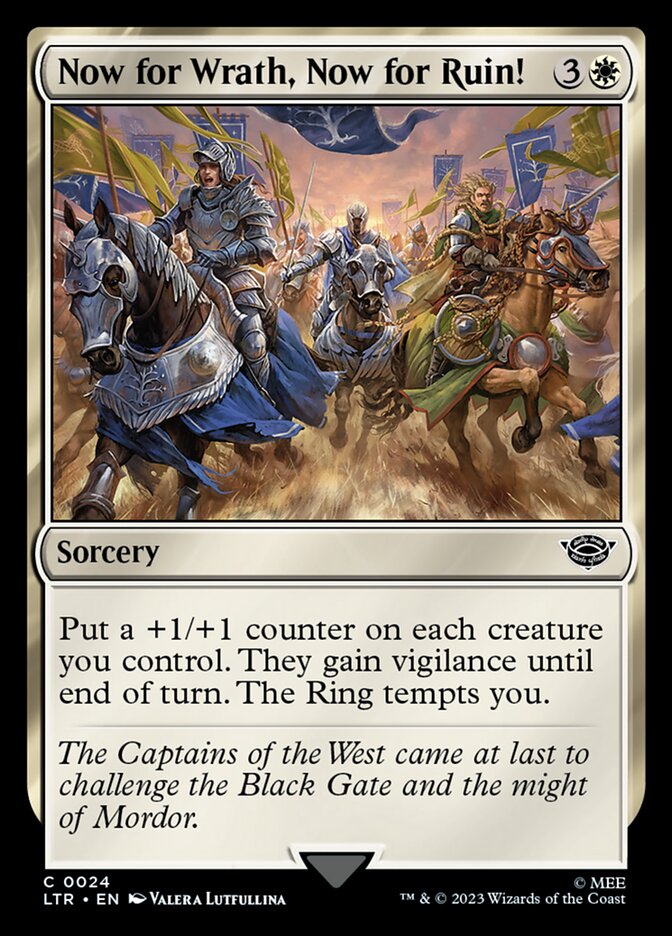

- Fog on the Barrow-Downs: White’s inevitable Pacifism effect is frankly overcosted and not great. But you’ll still play it.
- Now for Wrath, Now for Ruin!: This kind of mass pump effect is often seen in White, and often not considered very good. What’s the difference here? +1/+1 counters instead of a temporary buff for one thing. Vigilance for another. Having the Ring tempt you is a third. All of this together feels pretty good, especially in a color with a strong token theme.
- Reprieve: White does not have great hard removal options in LTR, but Reprieve is an amazing piece of interaction, often timewalking an opponent without putting you down a card.
Blue
Creatures
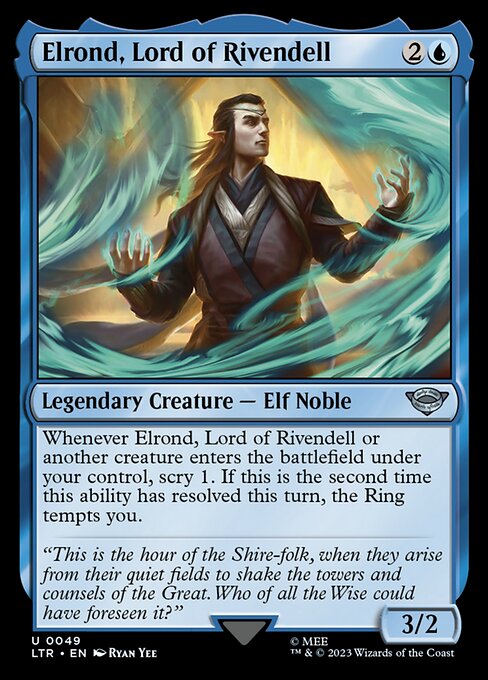
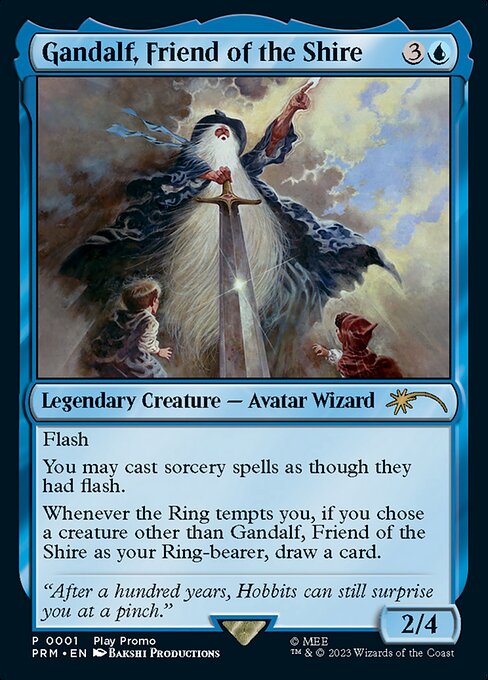
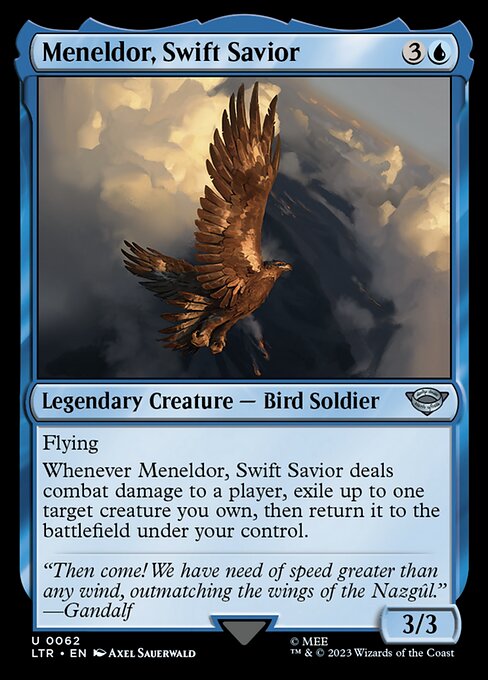
- Elrond, Lord of Rivendell: If you have a token heavy deck, then this Elrond will allow you to accelerate through the Ring’s track and maintain a constant stream of Ring-bearers. And even if you don’t, his repeatable scry ability will dig you to the cards you need while activating all your “if you scry” cards.
- Gandalf, Friend of the Shire: Not only can this snipe an attacker, it can act as repeatable card draw in the right deck.
- Meneldor, Swift Savior: LTR has a fair amount of creatures with enter-the-battlefield effects, and this bird is a great way to use them again and again and…
Non-Creatures
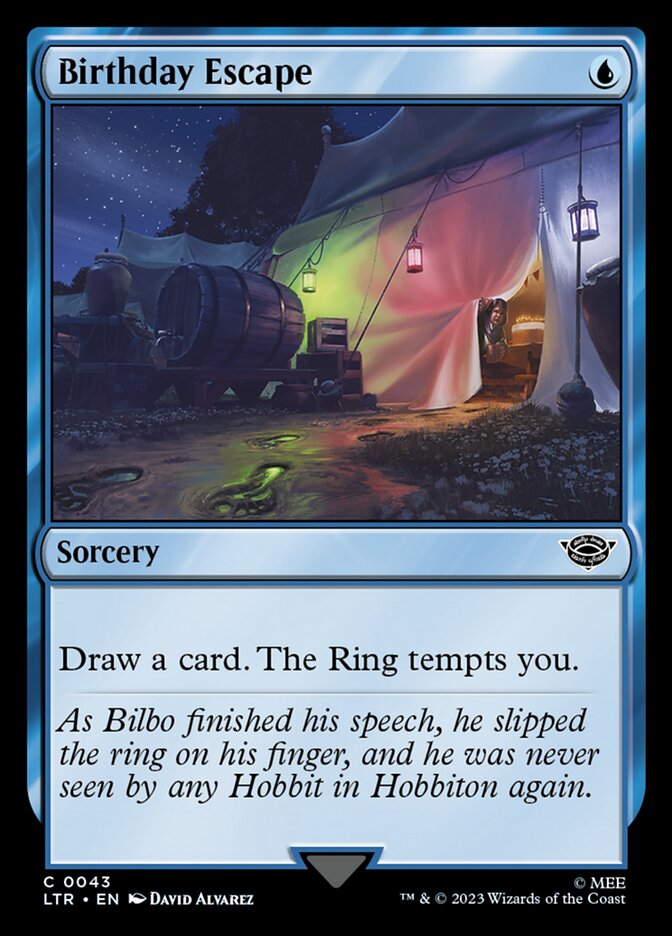
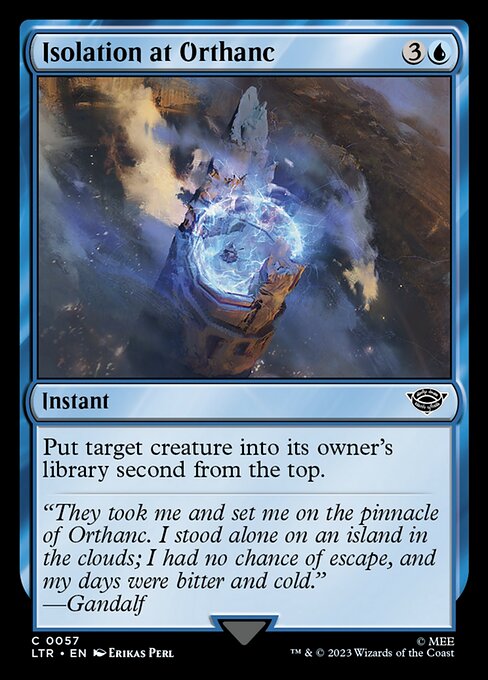
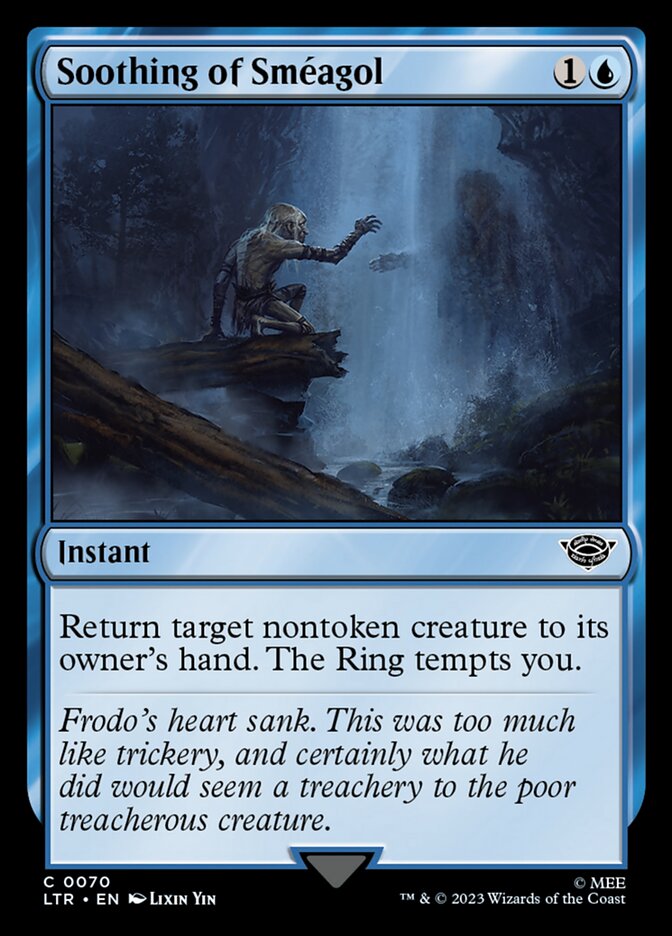
- Birthday Escape: A cheap way to create a Ring-bearer that also replaces itself that also plays well with draw-two synergies.
- Isolation at Orthanc: Blue’s interaction is pretty bad, but this spell is reasonably good at temporarily dealing with a creature, or permanently dealing with a token, or whisking a Ring-bearer off the battlefield..
- Smoothing of Sméagol: Although the inability to hit tokens is a real downside, a bounce spell is decent in a set full of pesky Ring-bearers. Creating a Ring-bearer of your own is a substantial bonus.
Black
Creatures

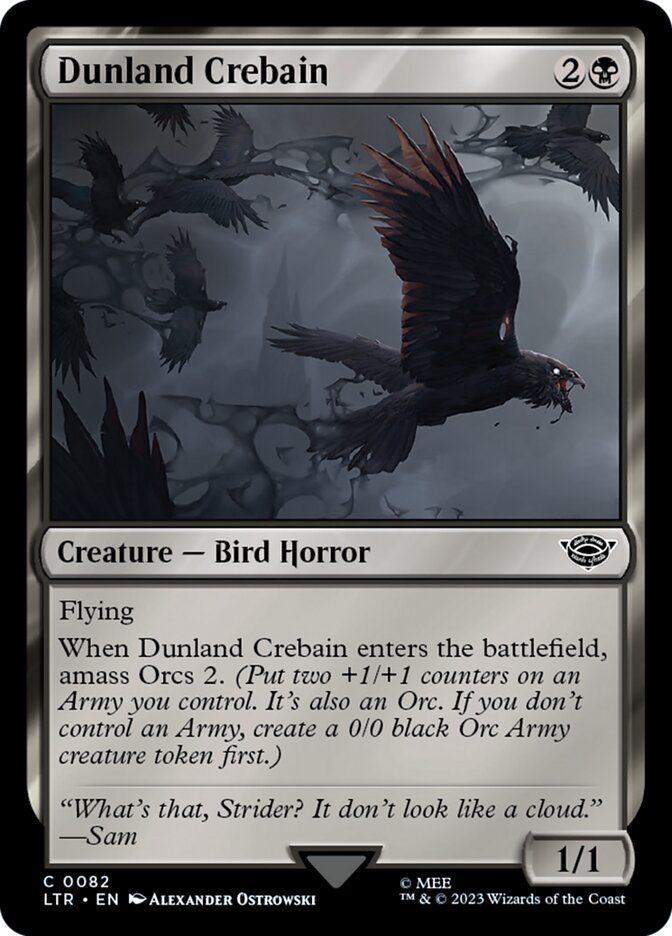
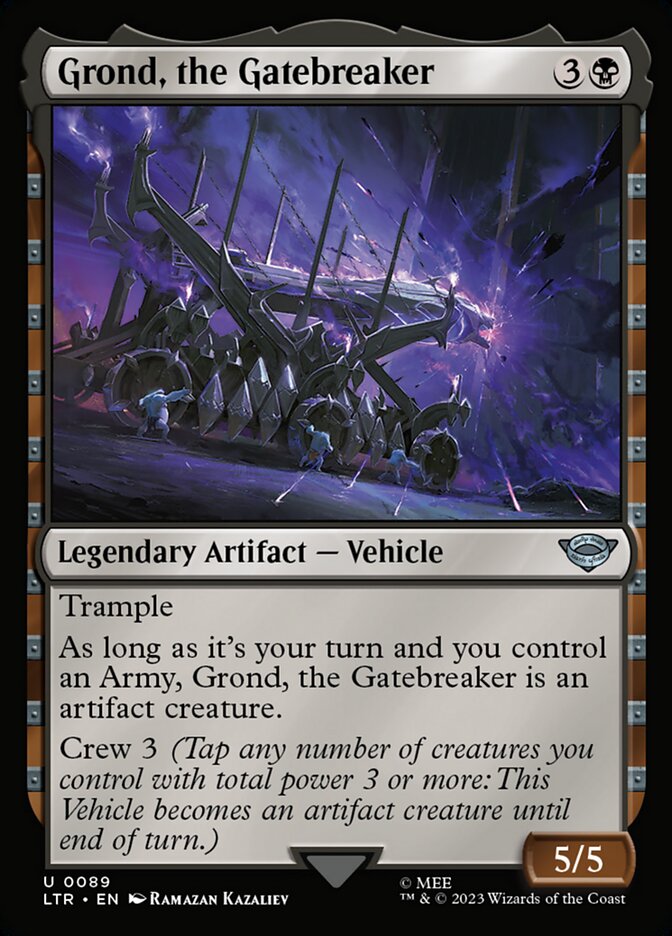
- Cirith Ungol Patrol: Okay, maybe you don’t want this in an aggro deck. But any midrange or control deck would love a creature that coverts your expendable fodder into cards and life.
- Dunland Crebain: Three mana for three power and toughness split over two bodies is good, and having synergies with tokens and Amass is really good.
- Grond, the Gatebreaker: This non-creature is an amazing creature in an Amass deck. But what if you don’t control an Army? Well, this vehicle’s mana cost and crew cost are still good enough to make it an effective presence on the battlefield.
Non-Creatures
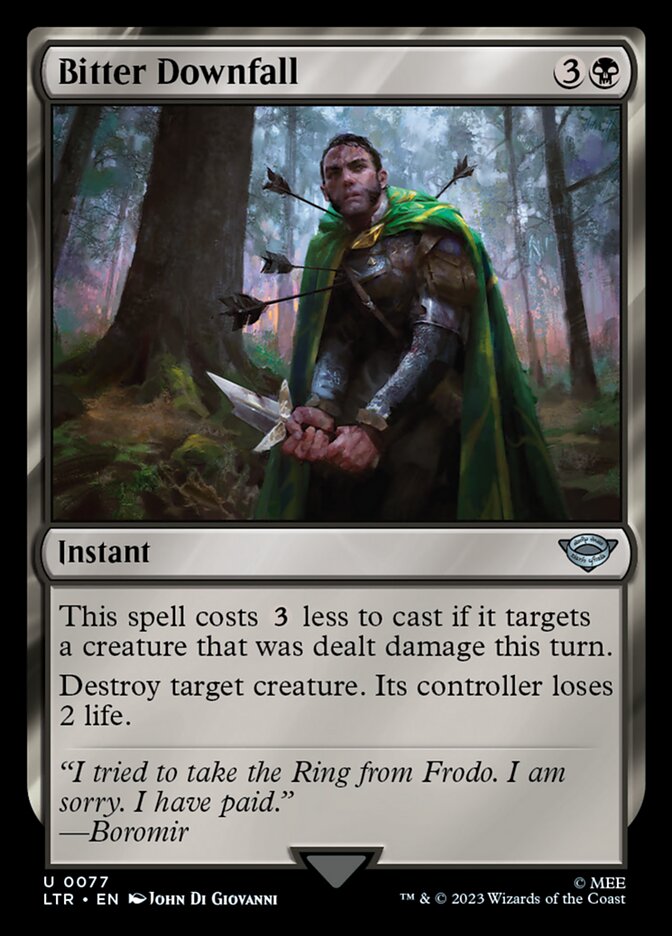
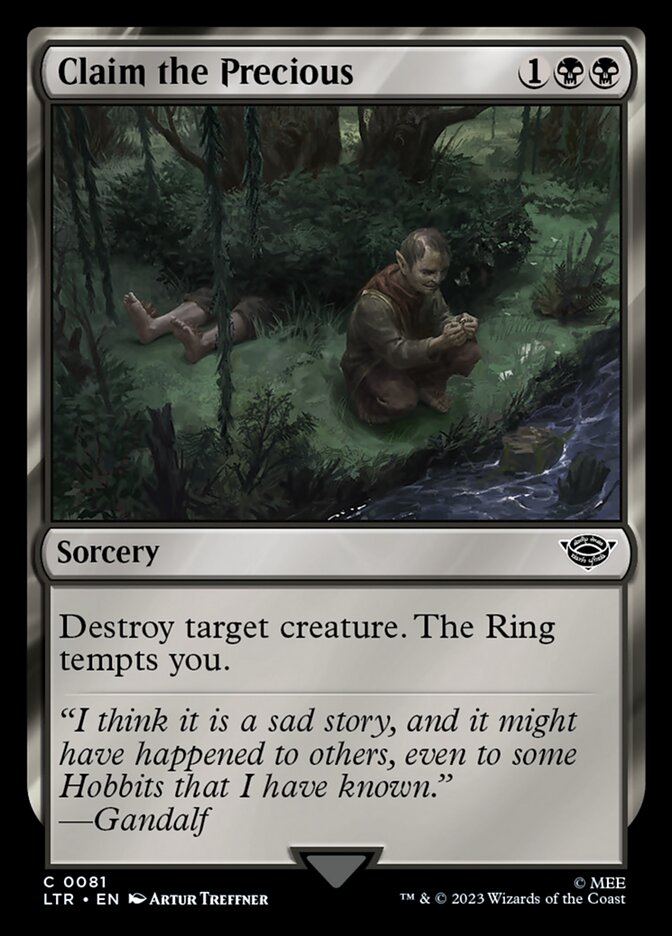
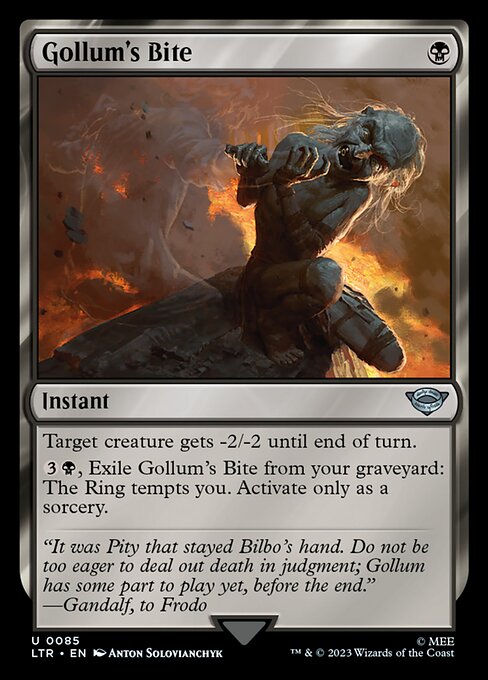
- Bitter Downfall: Here’s the traditional four-mana Black Limited kill spell. Spoiler alert: they’re all great.
- Claim the Precious: Murder at sorcery-speed is disappointing, but moving up the Ring’s track and creating a Ring-bearer is a welcome trade-off.
- Gollum’s Bite: This instant seems like an efficient way to snipe small Ring-bearers, and later in the game it’ll allow you to create one of your very own.
Red
Creatures

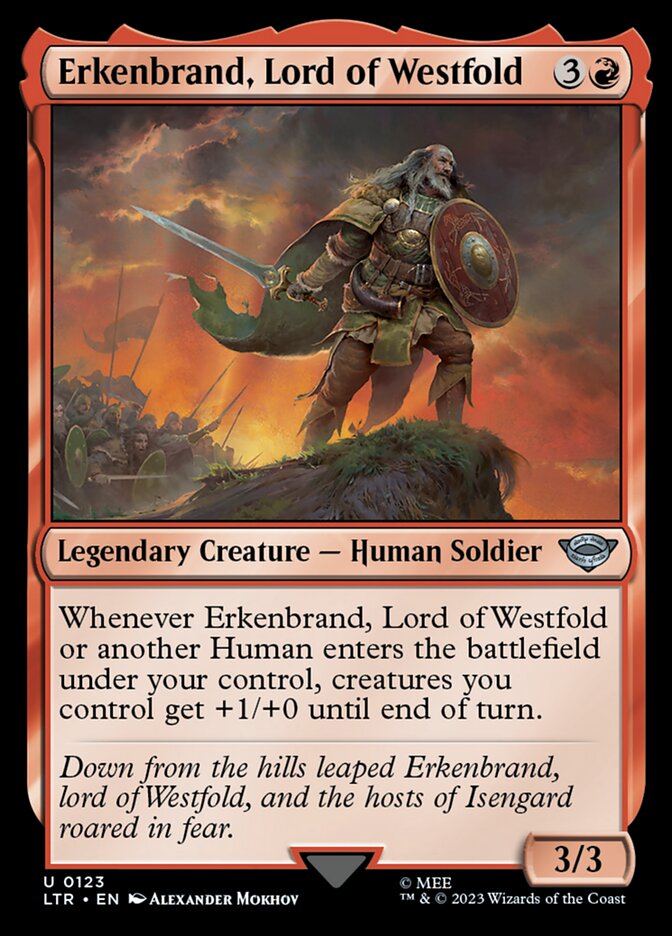
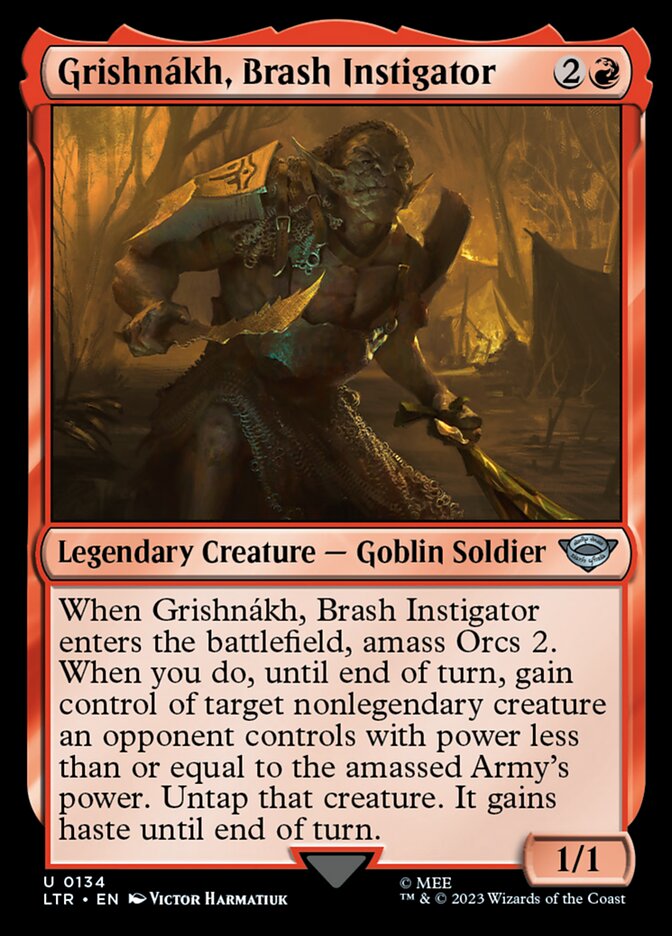
- Éomer of the Riddermark: This is an amazing curve-topper for any Red deck that cares about attacking, which should be all of them.
- Erkenbrand, Lord of Westfold: This creature would be okay if it could only trigger once. The fact that it can trigger multiple times in a turn makes it a nightmare threat for your opponent to face down.
- Grishnákh, Brash Instigator: It’s legendary, it has Amass, and it grabs an opponent’s creature in a set full of sacrifice effects.
Non-Creatures
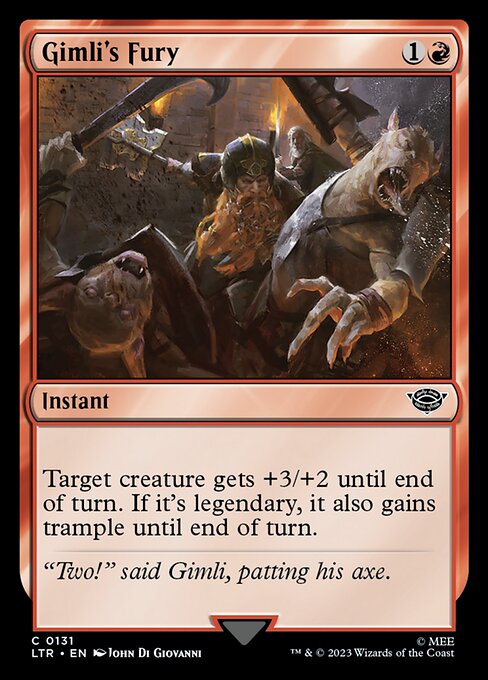
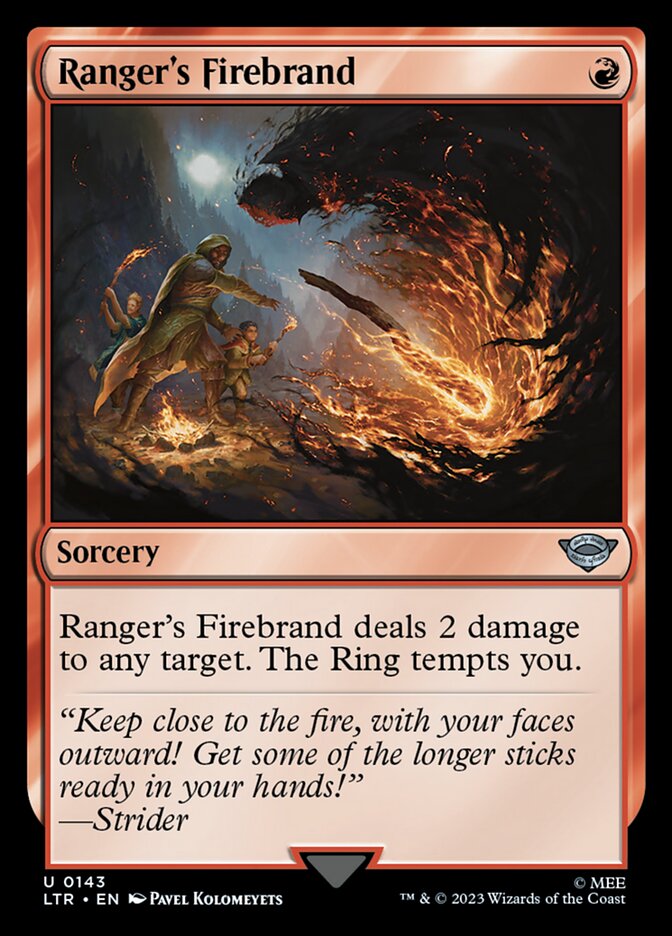
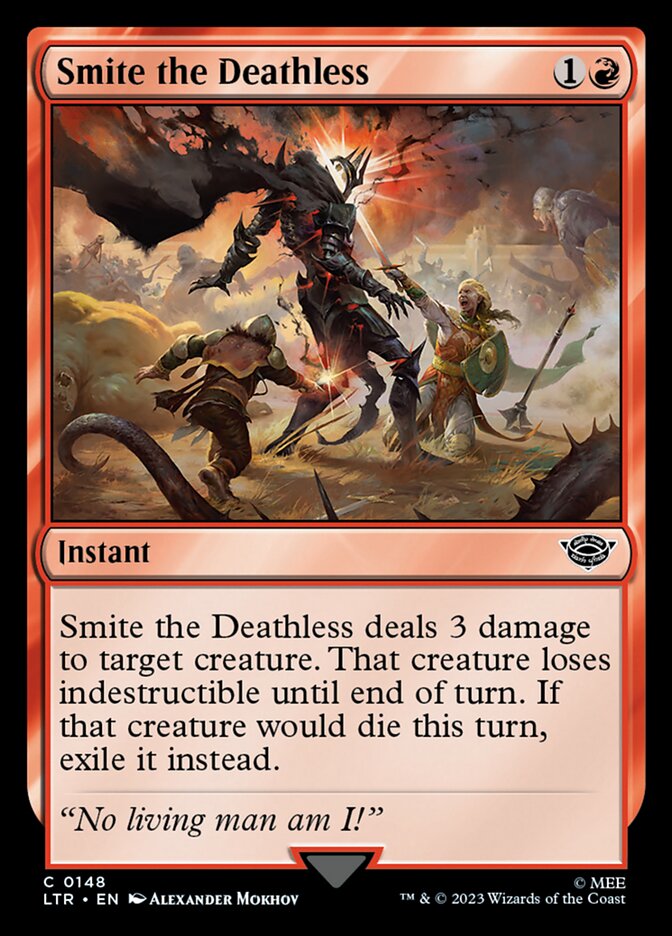
- Gimli’s Fury: Pump spells aren’t always great, but this one is chunky enough to end games.
- Ranger’s Firebrand: This card would be so much better if it were an instant. But it still does reasonable things at a reasonable rate.
- Smite the Deathless: Two mana for three damage to a creature is pretty standard Limited fare. That doesn’t make it less tasty.
Green
Creatures
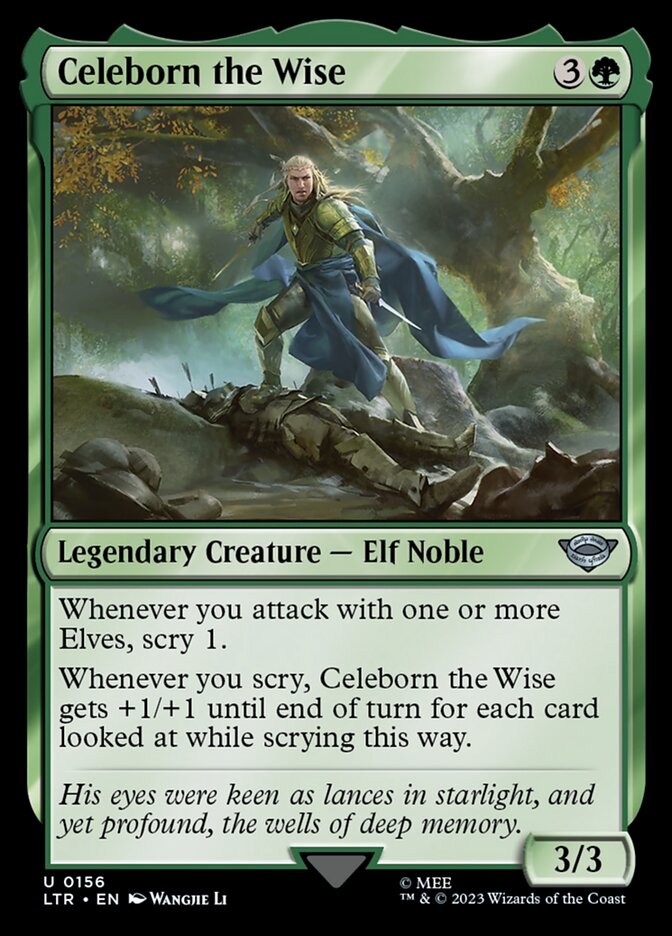
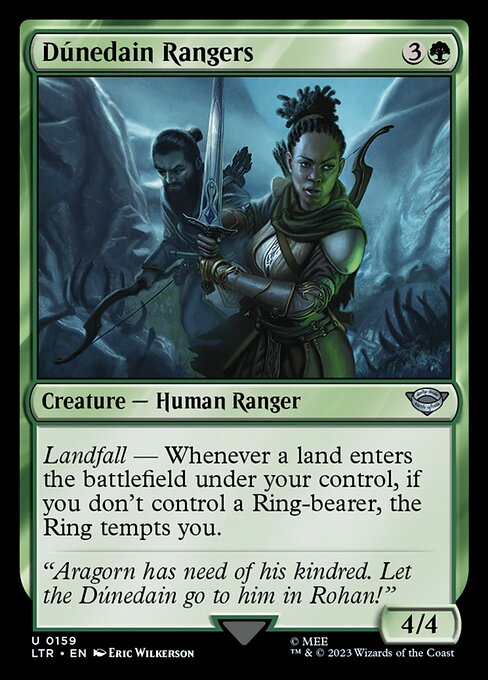

- Celeborn the Wise: Repeatable scry is extremely good (and extremely demoralizing for your opponent). And if you have enough Elves on your side, his intelligent scry ability will also smash your opponent extremely hard.
- Dúnedain Rangers: A 4/4 for four mana is reasonable, and this creature’s added effect has an air of inevitability about it.
- Quickbeam, Upstart Ent: Uh, ow. Not only is this six mana creature hard to get past; it has an extremely threatening enters-the-battlefield effect that can win the game on the spot. And if it doesn’t, well, just cast another Treefolk next turn and trample your way to victory.
Non-Creatures
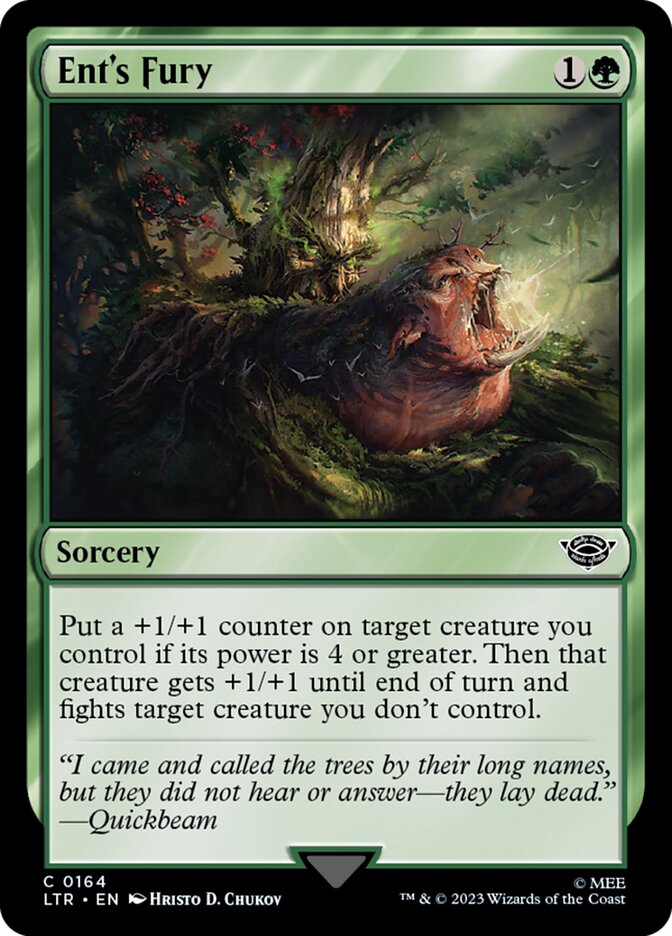
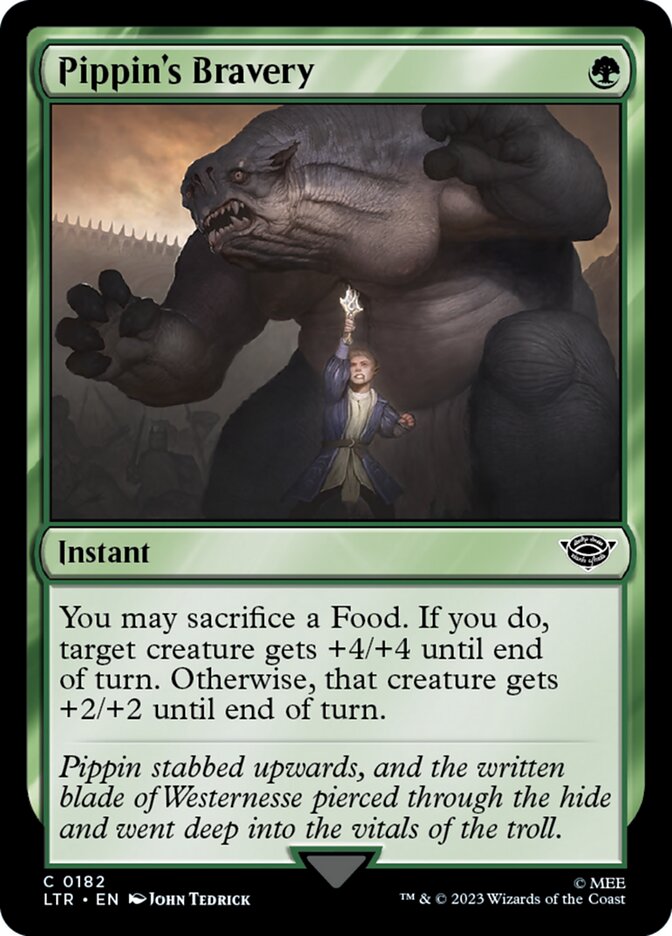
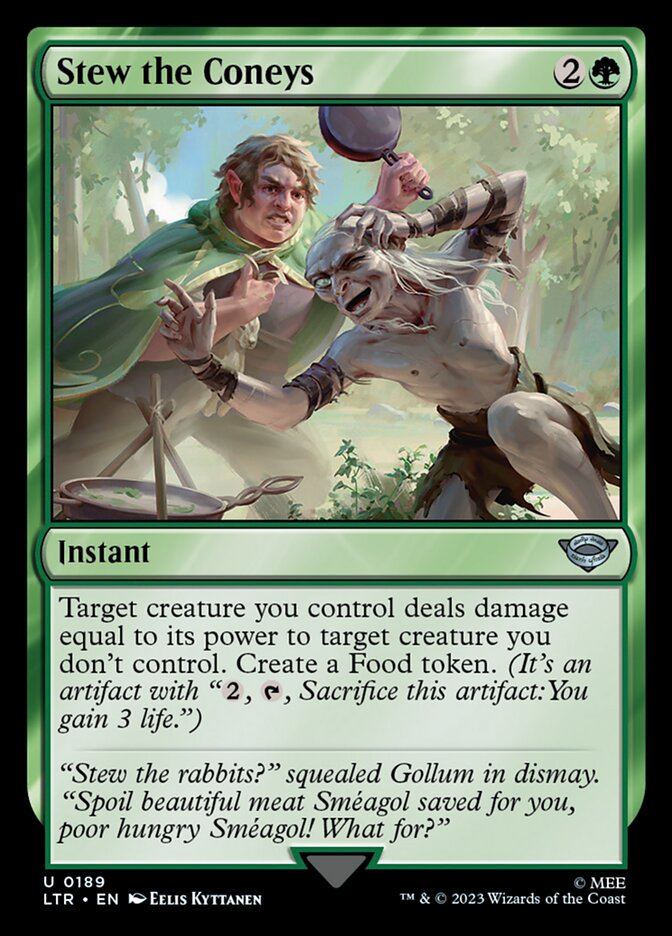
- Ent’s Fury: This fight spell is fine even if you don’t control a creature with power 4 or greater. And if you do, well, wow.
- Pippin’s Bravery: An instant speed pump spell is kind of like a riskier, more situational removal spell that can also give you surprise lethal. And the card’s potential to add four power and toughness for only a single mana means that your opponent often won’t see this swing coming.
- Stew the Coneys: And here’s a nice little punch that feels like a slightly overcosted removal spell. Be that as it may, it’s still an instant-speed removal spell.
Summation
So what can we conclude about Lord of the Rings from all of this information?
- The Ring is a complex mechanic that changes For example:
- All Ring-bearers are now threats. Should you save your removal for traditional bombs, or use it to take out tiny hobbit Ring-bearers?
- Knowing your opponent will try and kill your Ring-bearers, should you use your “Ring tempts you” effects as soon as possible to power up your Ring, or save them so you can create a new Ring-bearer?
- Creatures with low power and high toughness are traditionally mediocre in Limited. However in LTR they make ideal Ring-bearers, and should be valued more highly.
- Removal is not great in LTR. Hoard it carefully, use it selectively, and eke out advantages in other ways.
- Cheap instant-speed combat tricks are a reasonable substitute for removal, and such spells are even better because they make it easier to take out a Ring-bearer with low power and high toughness.
- Do your best to keep your Legendary creatures around. Find ways to protect them, or revive them, or force your opponent to deal with your other creatures instead.
Good luck!










